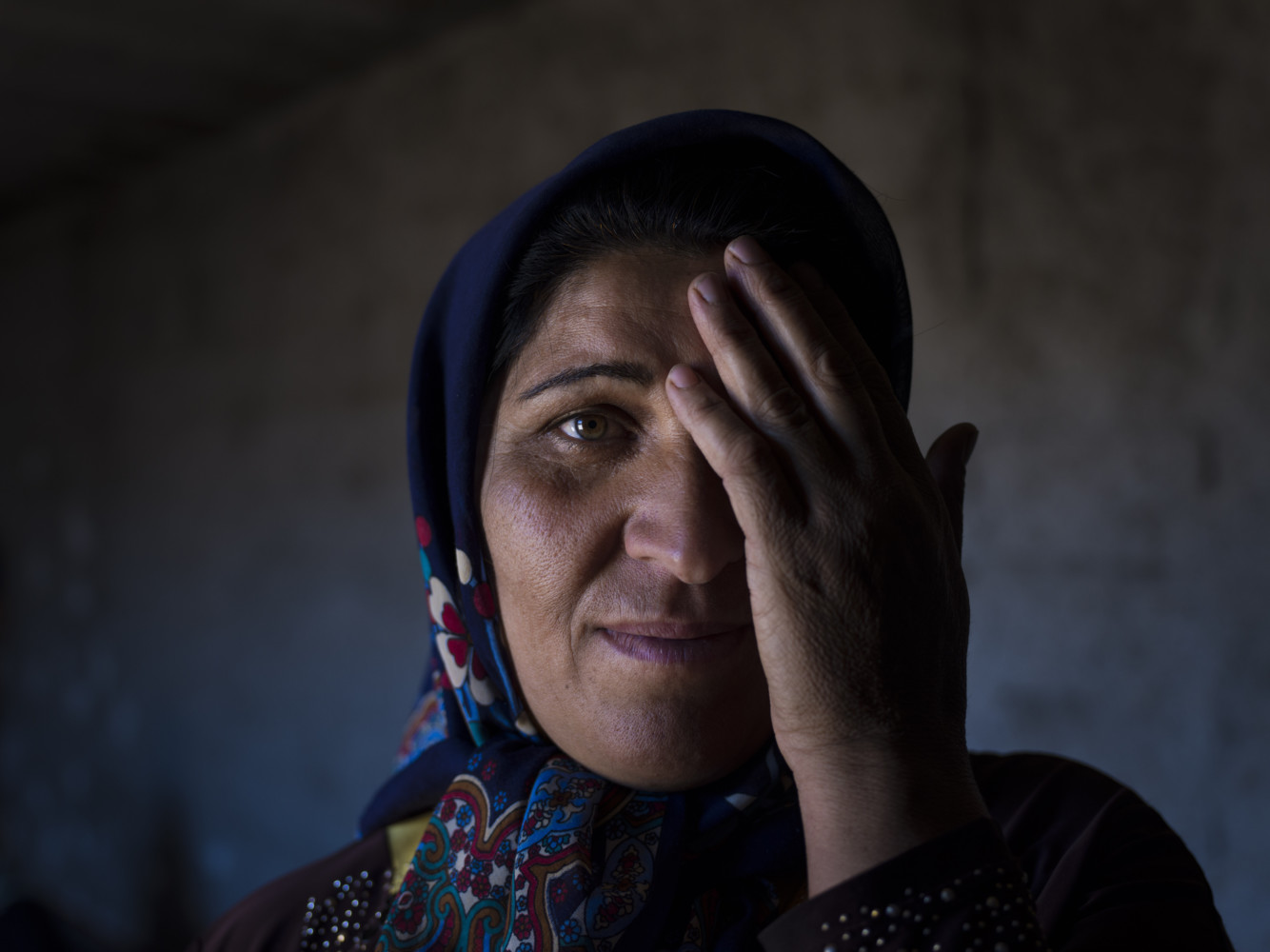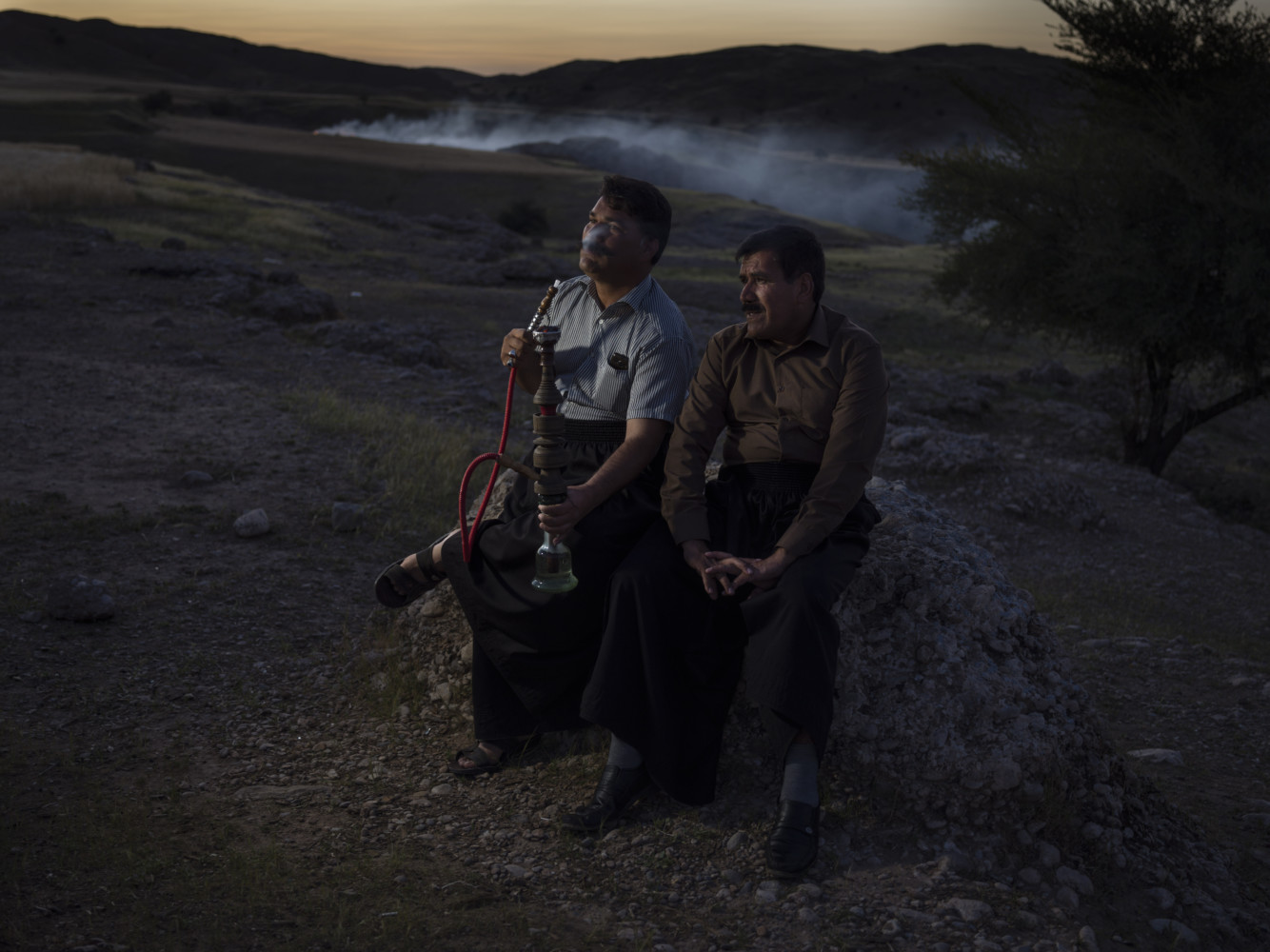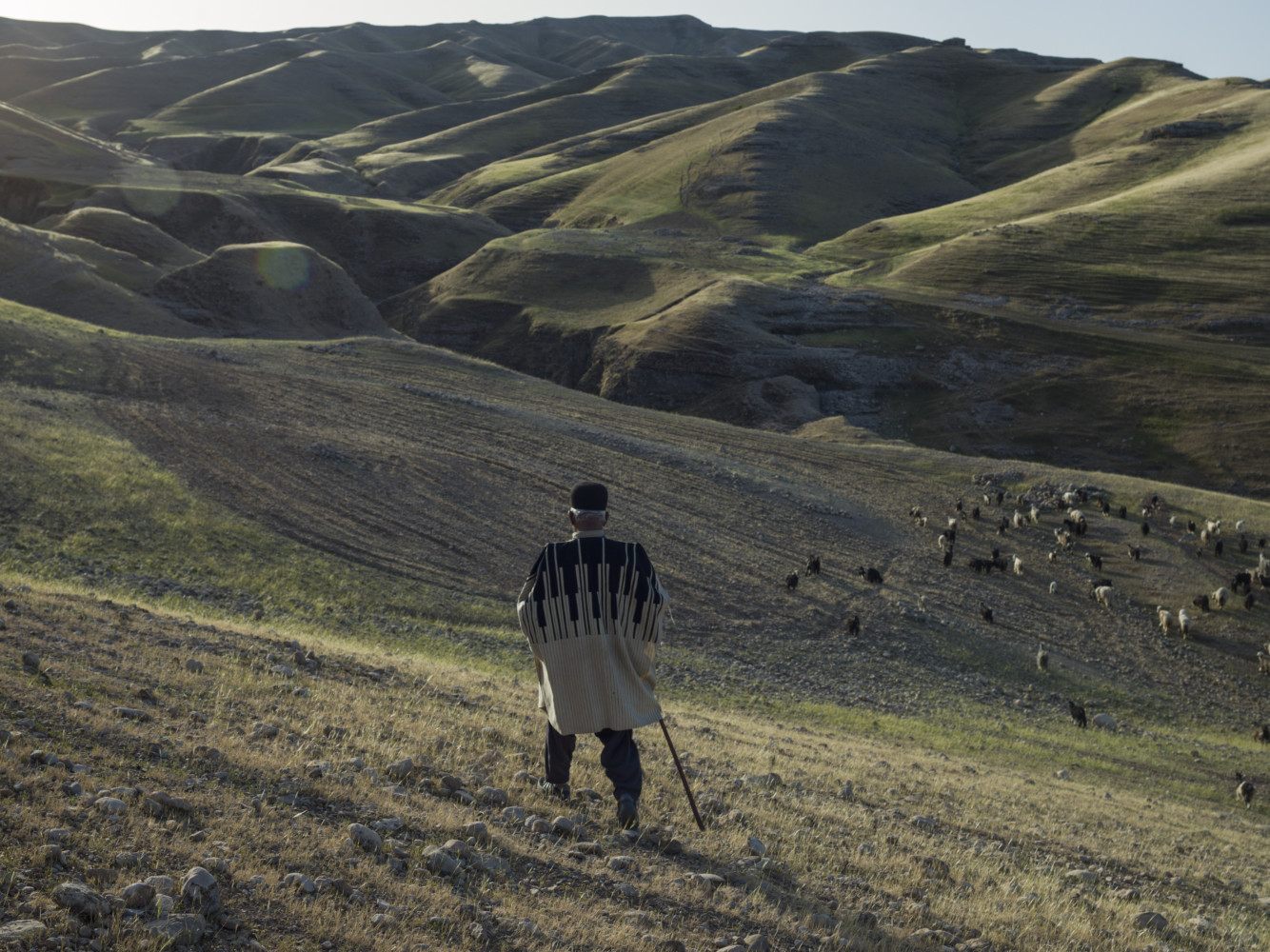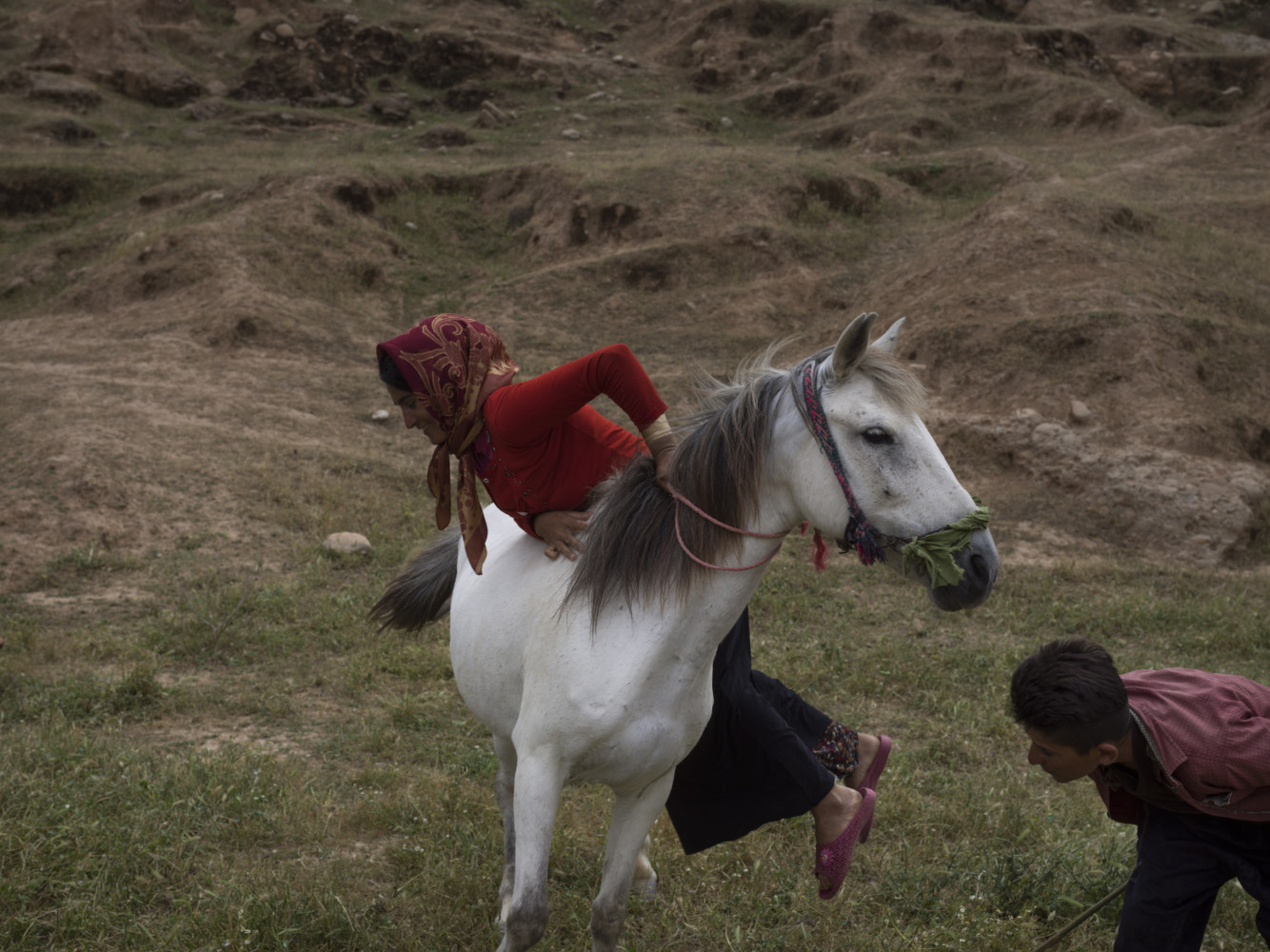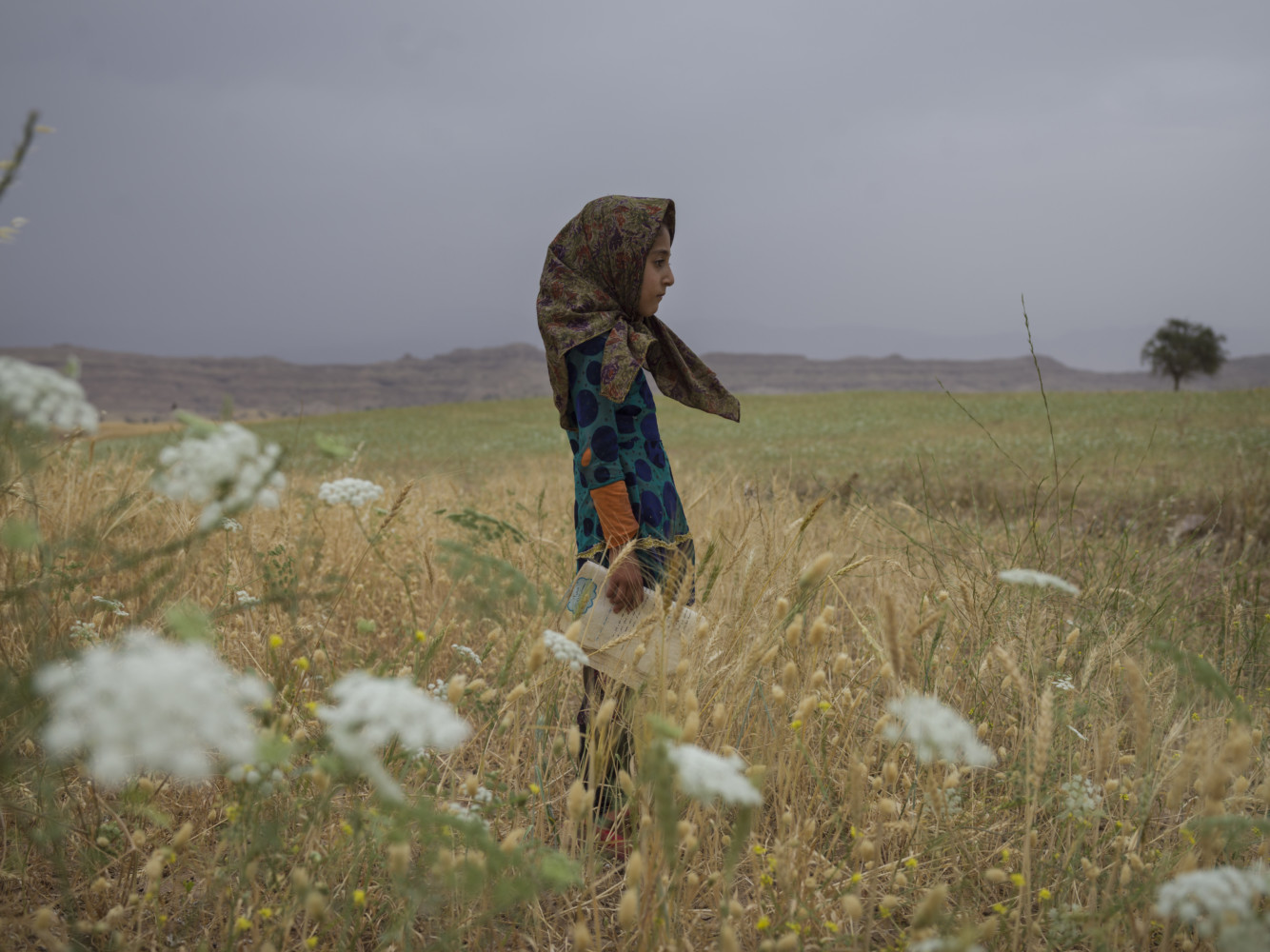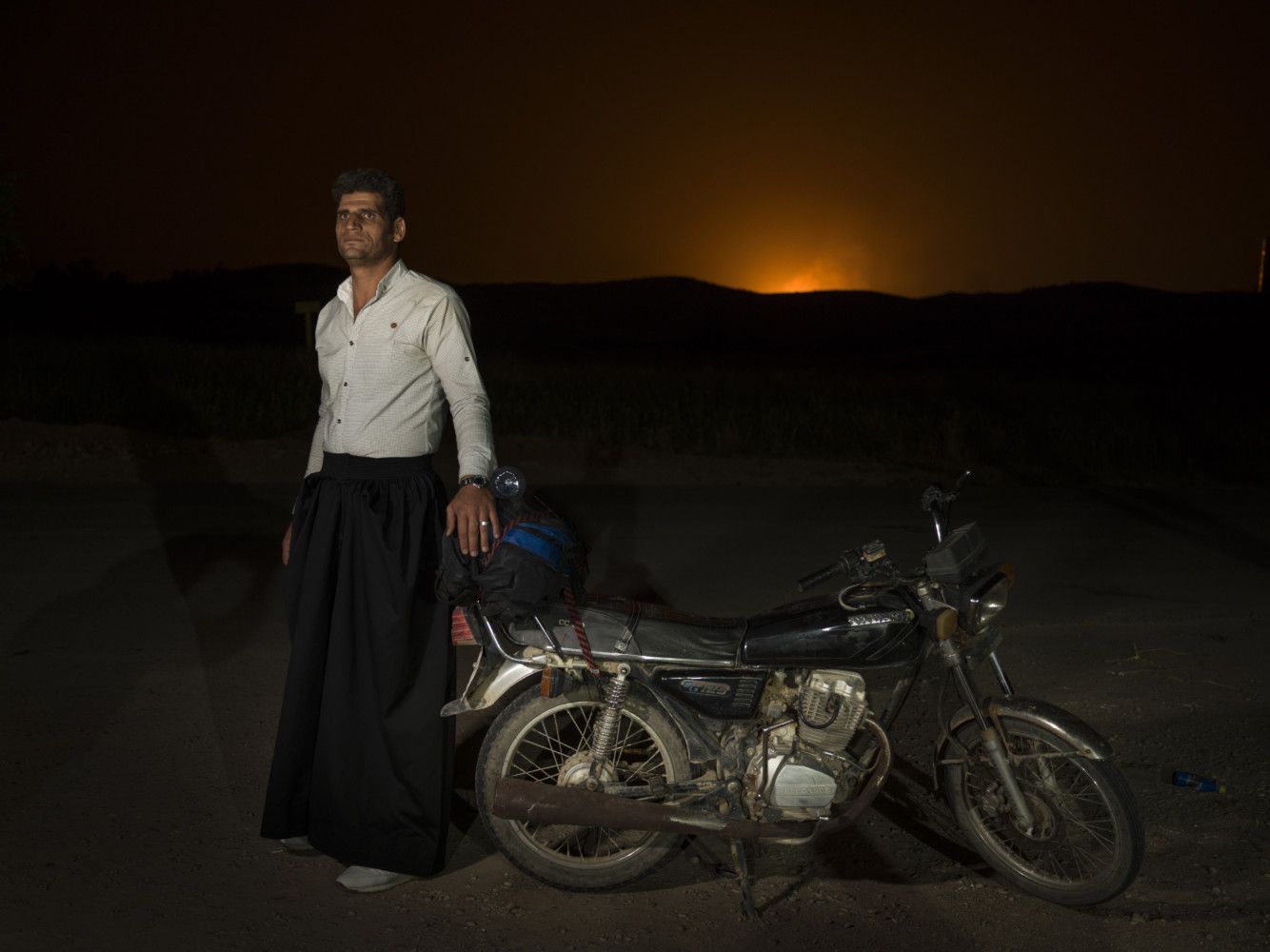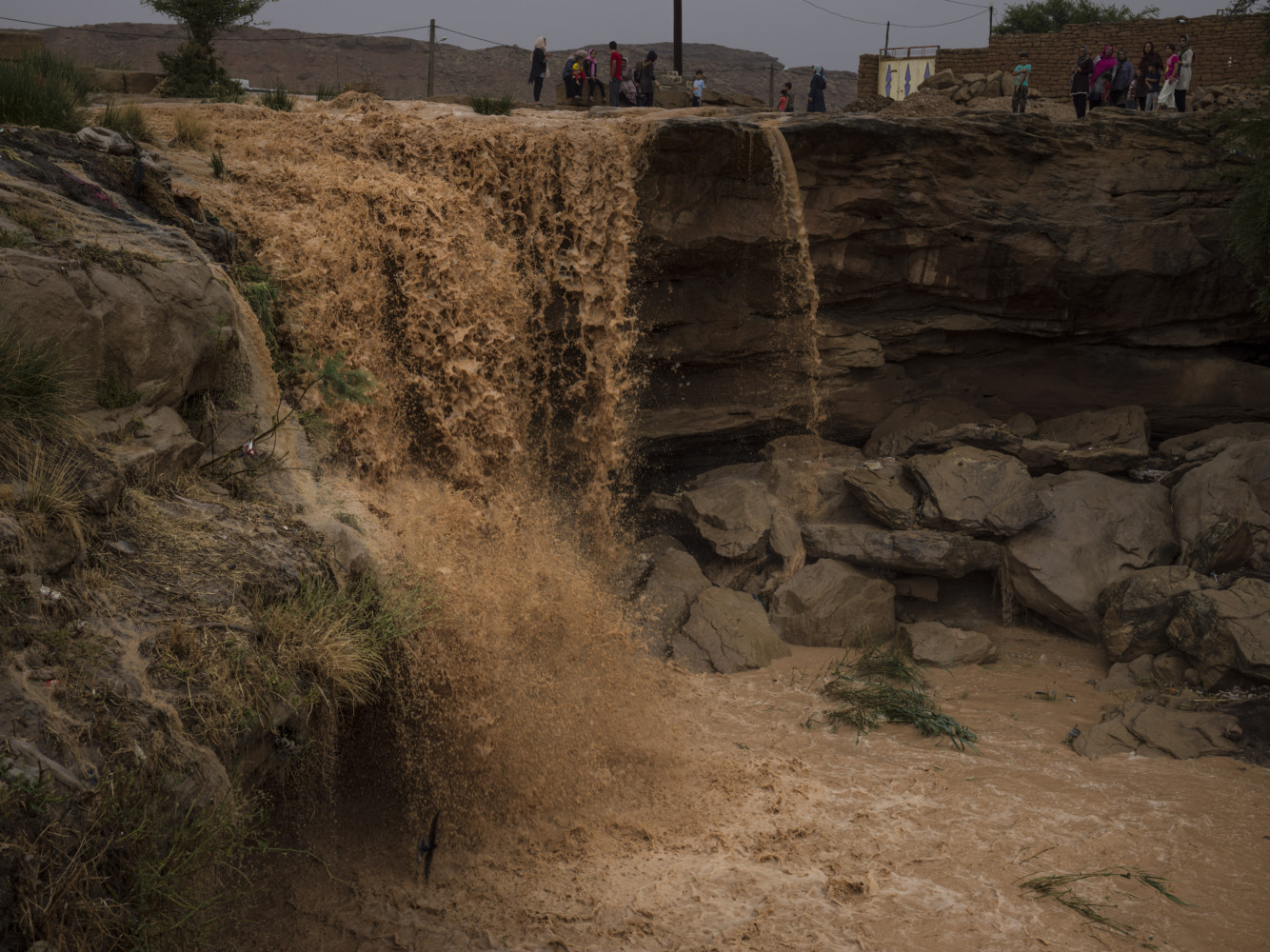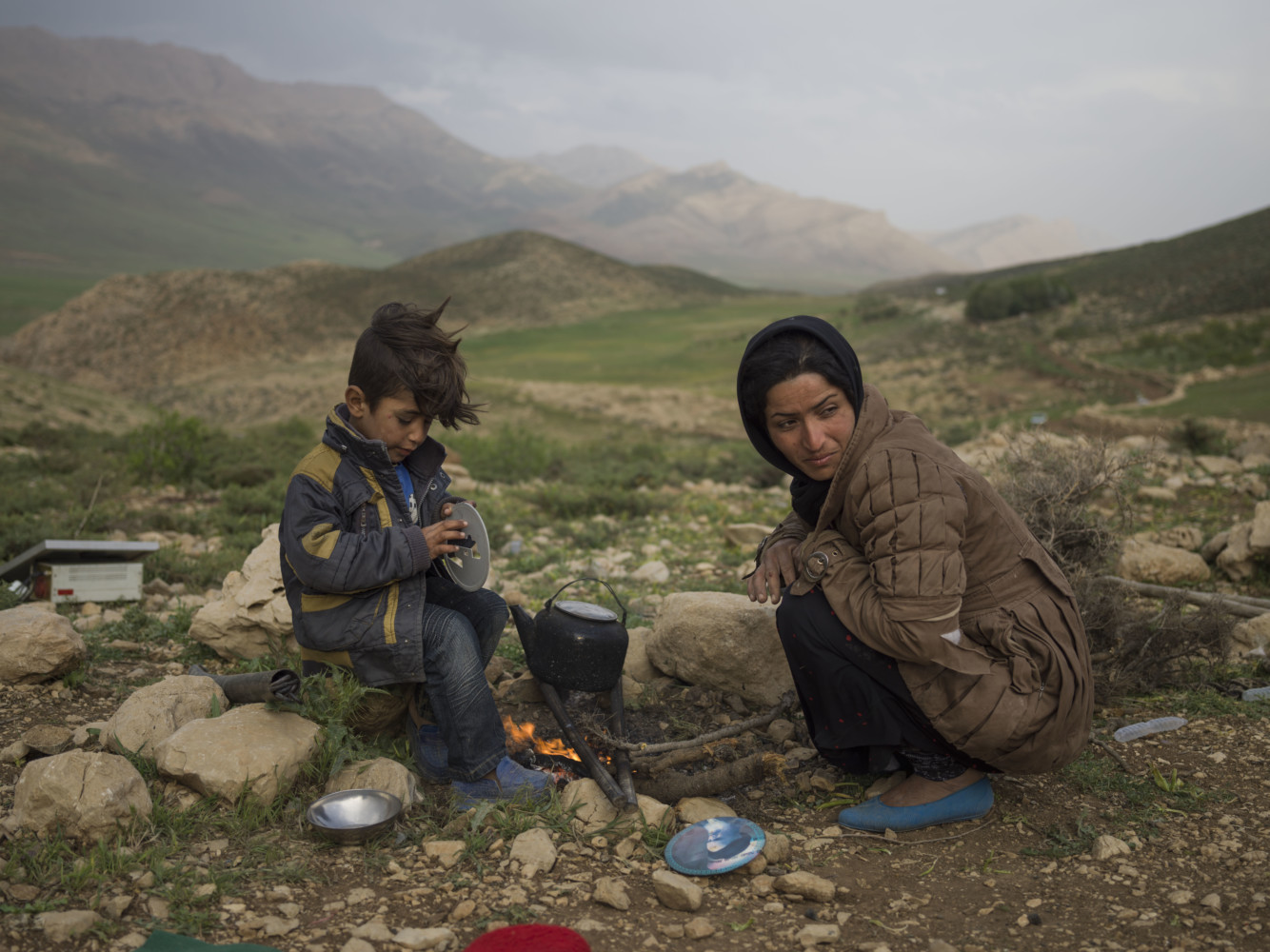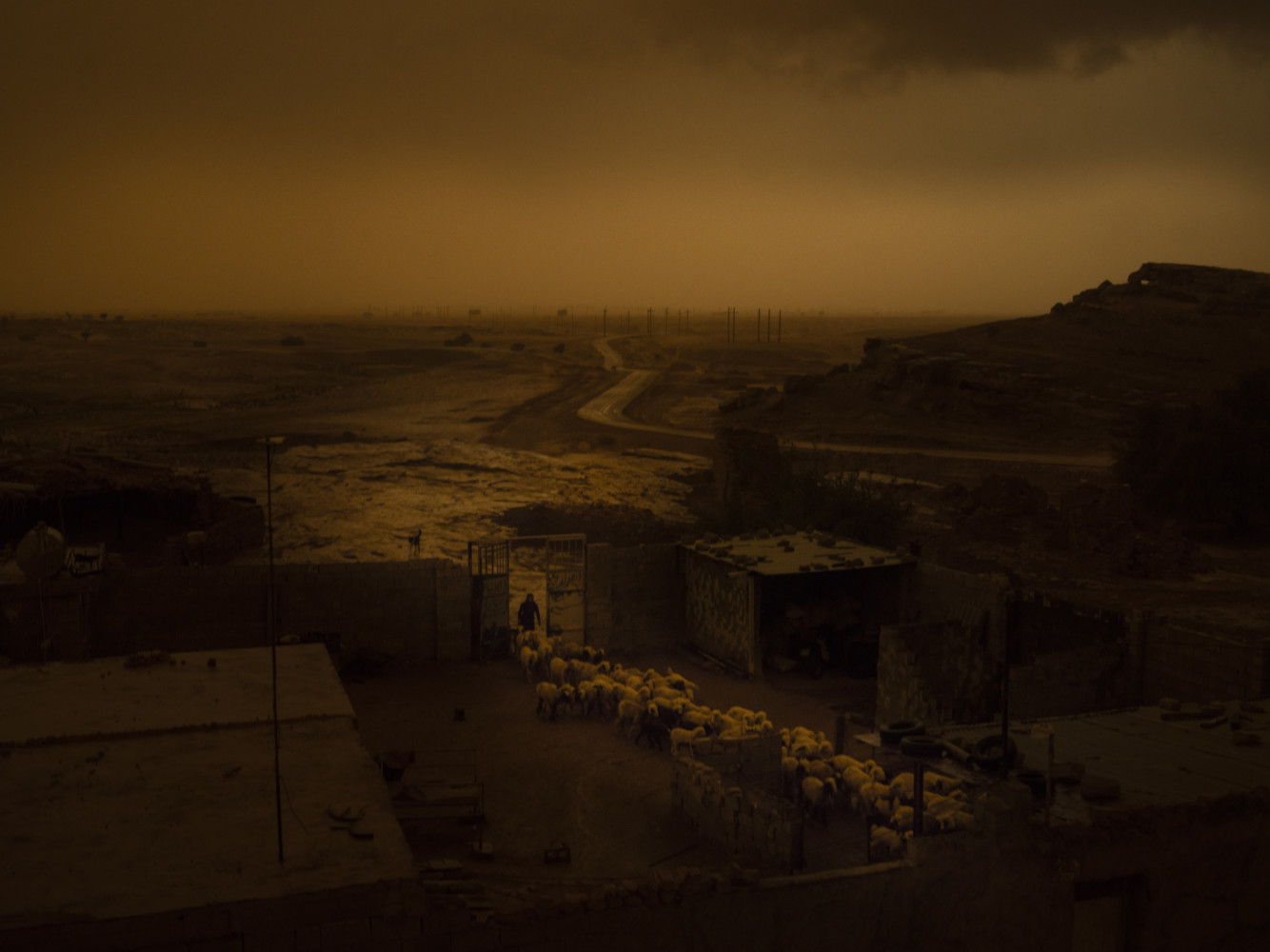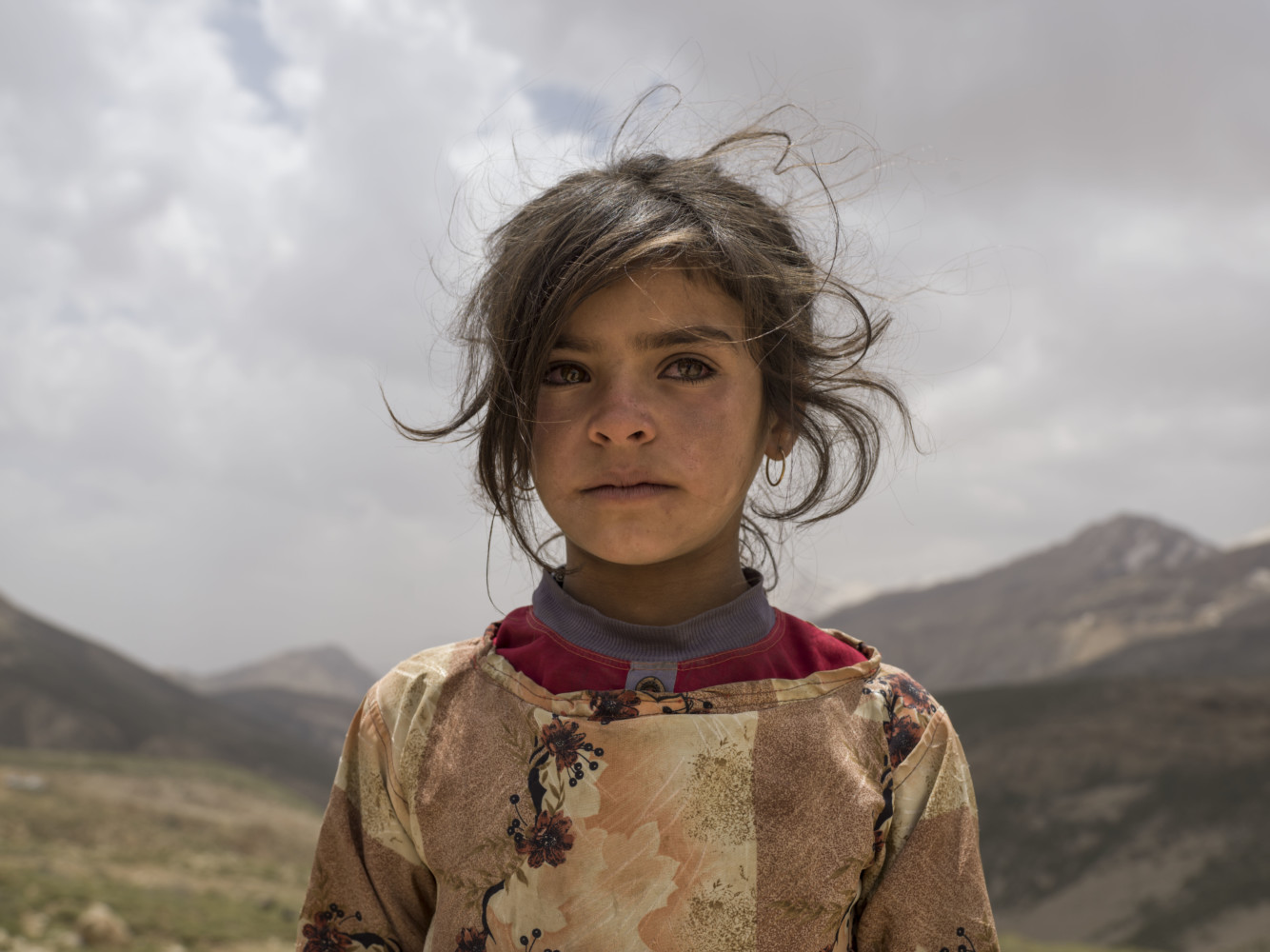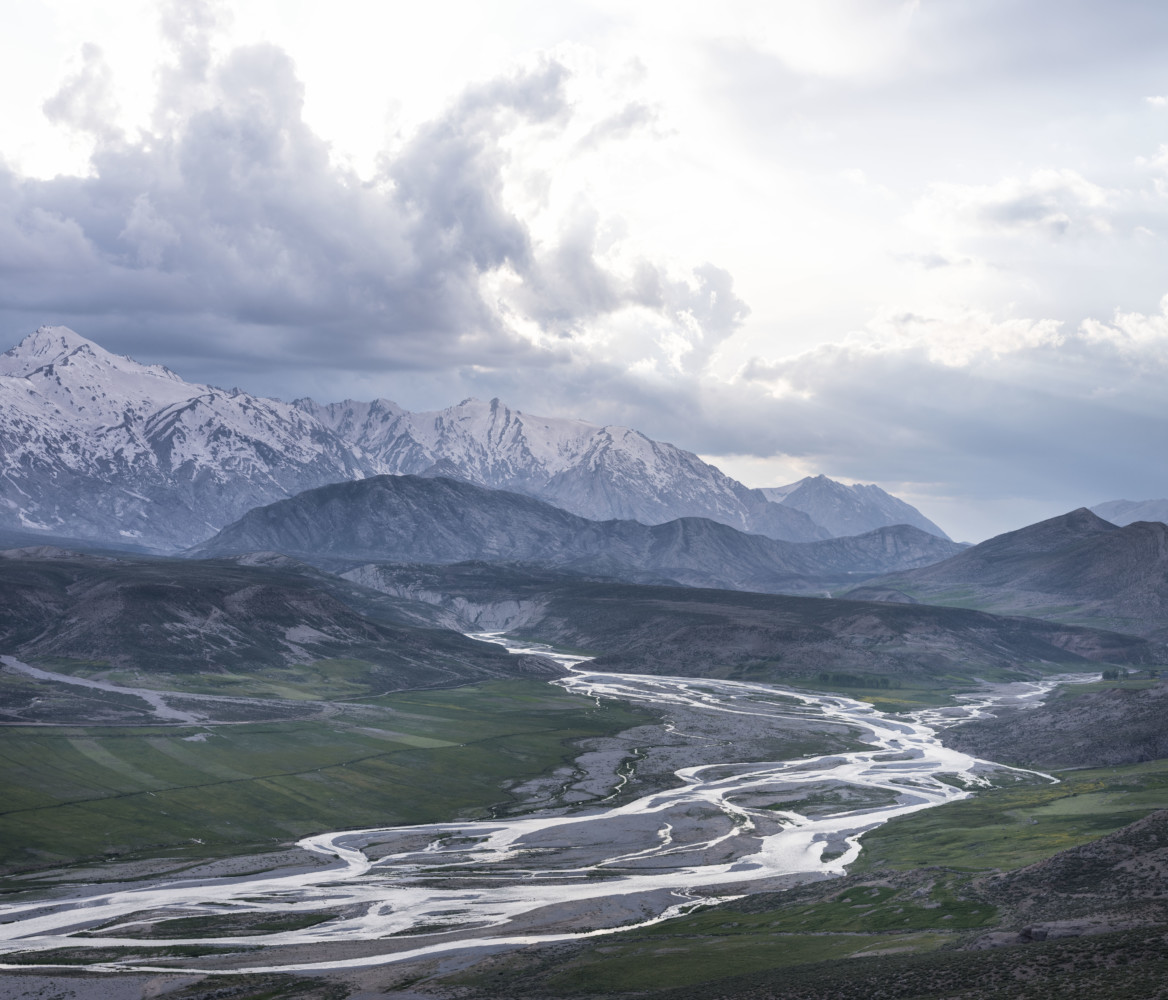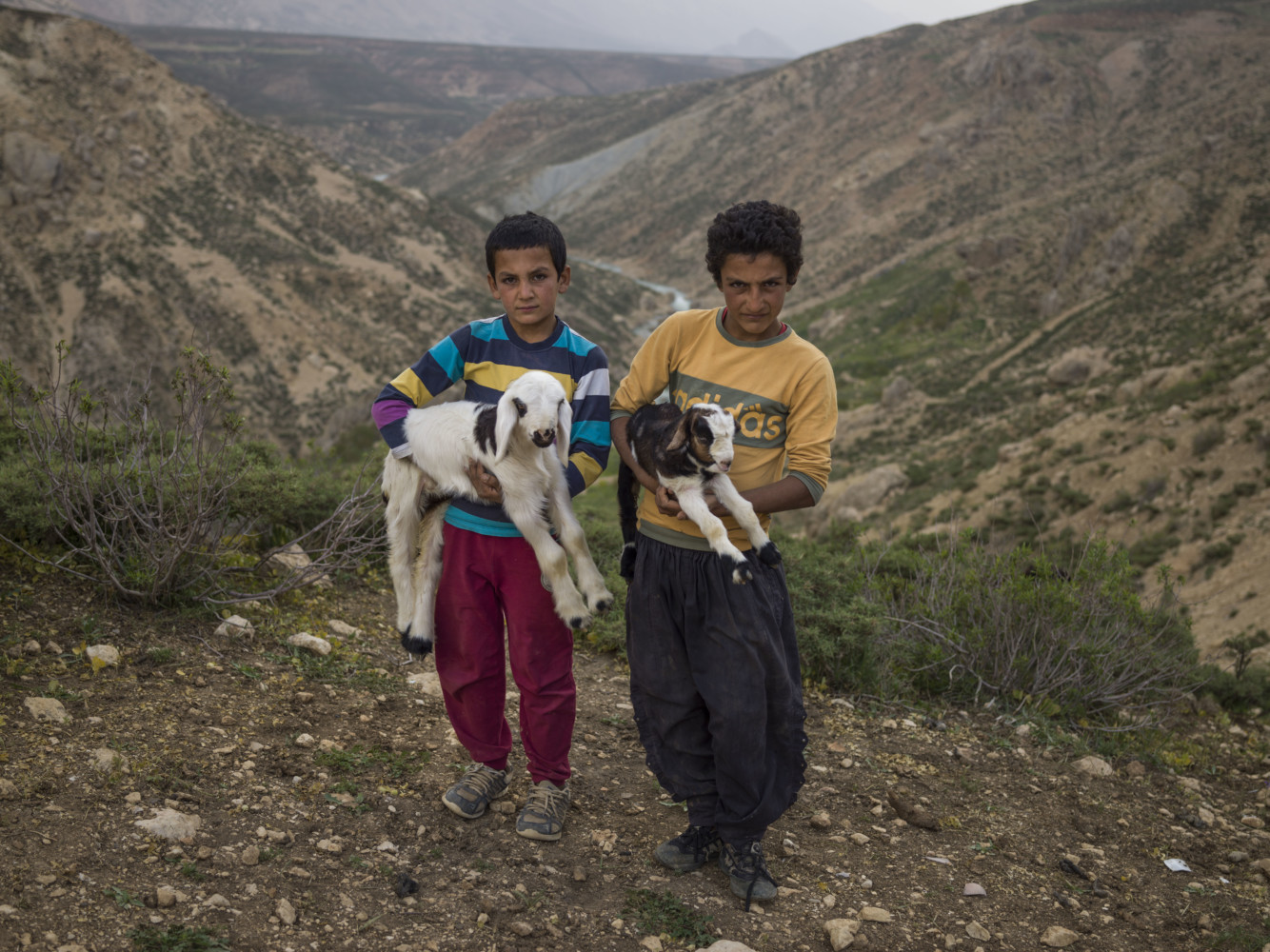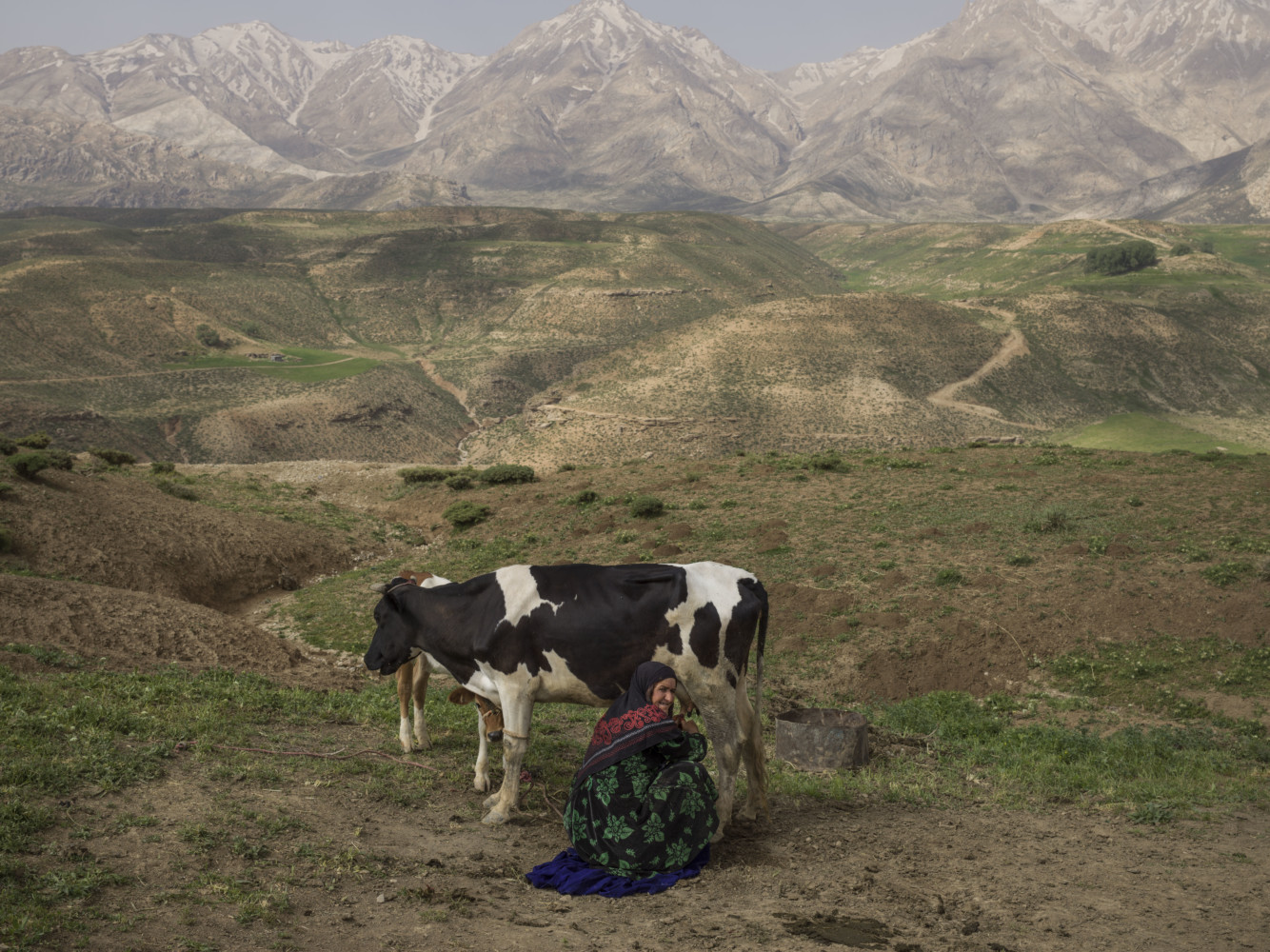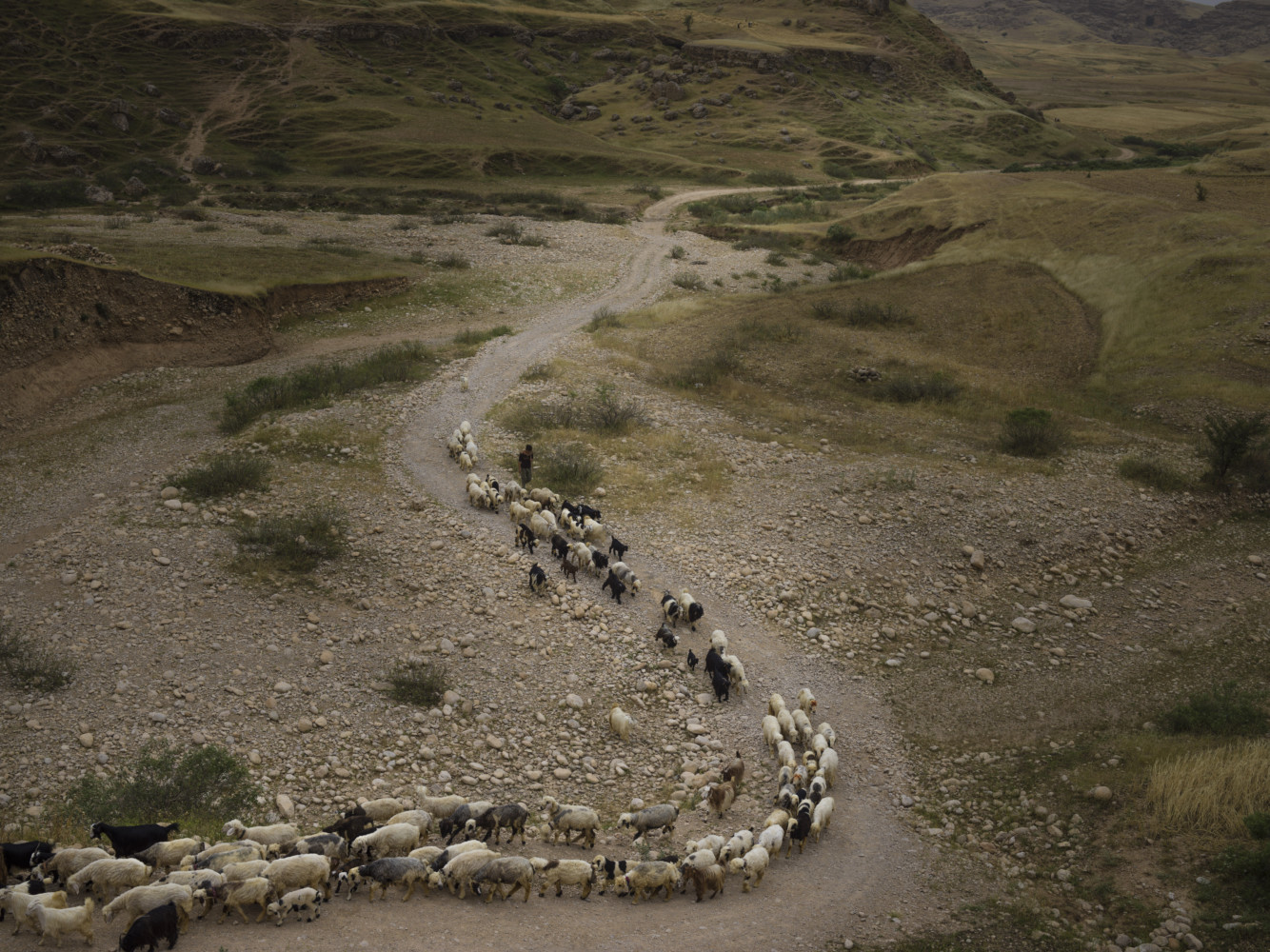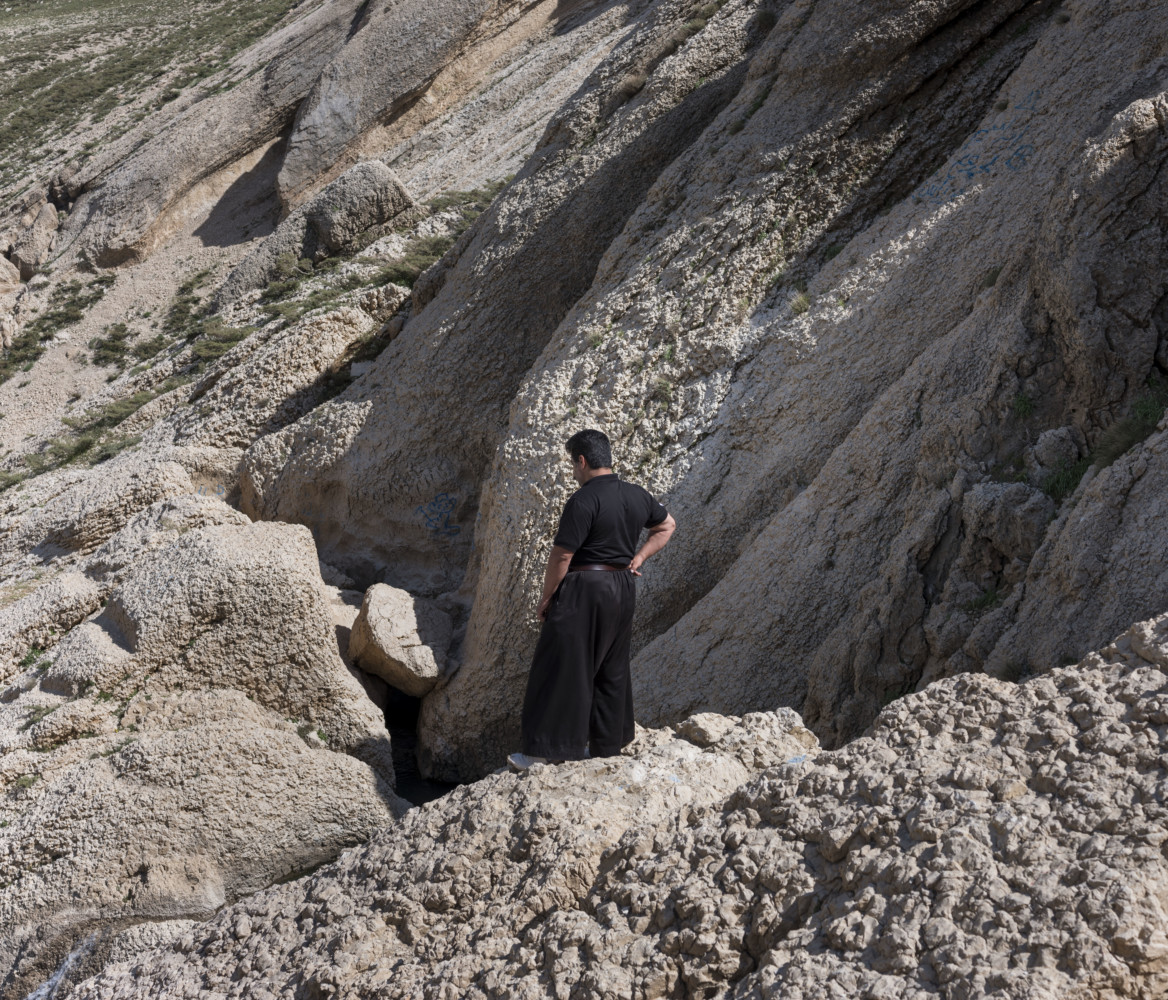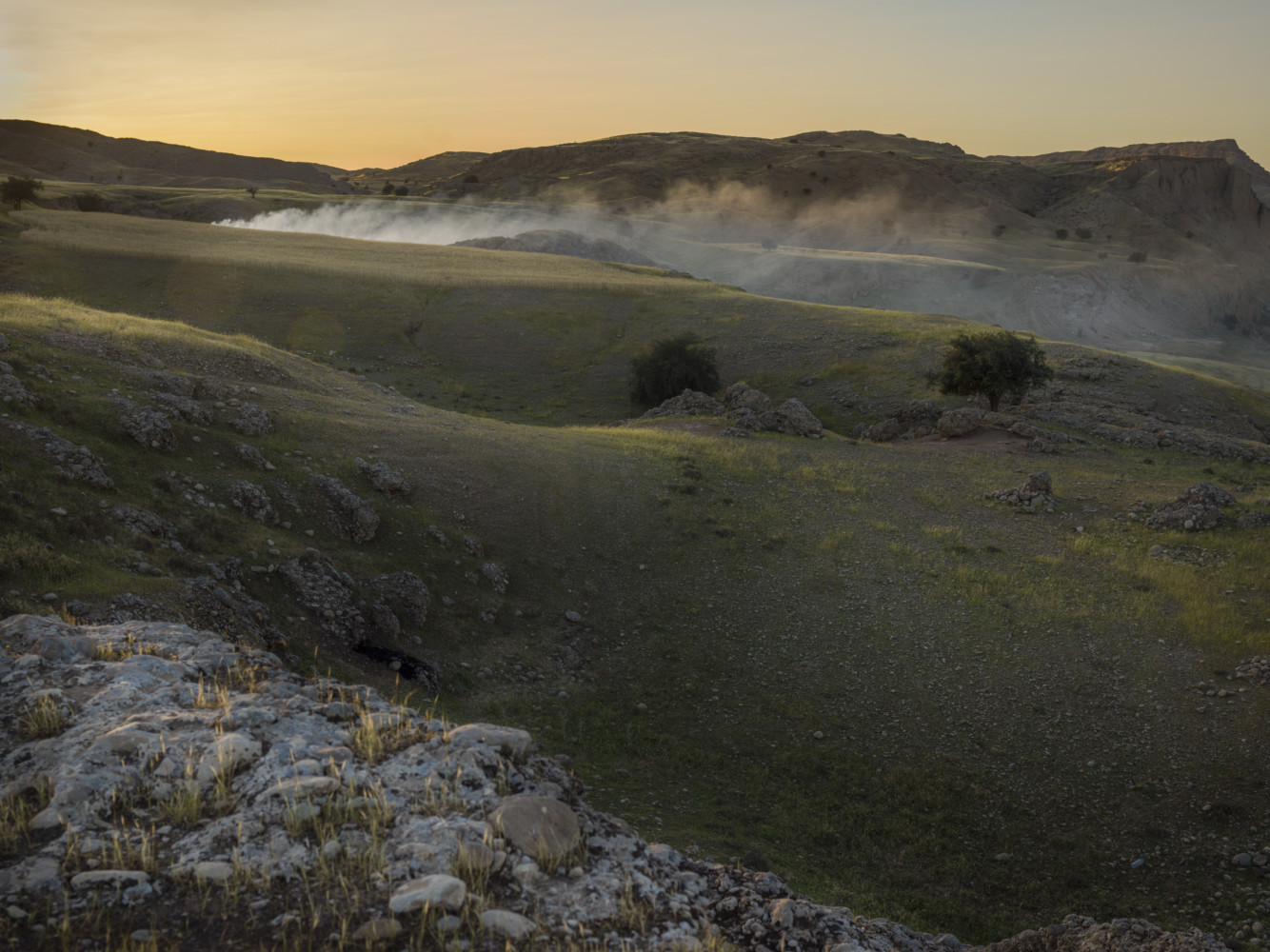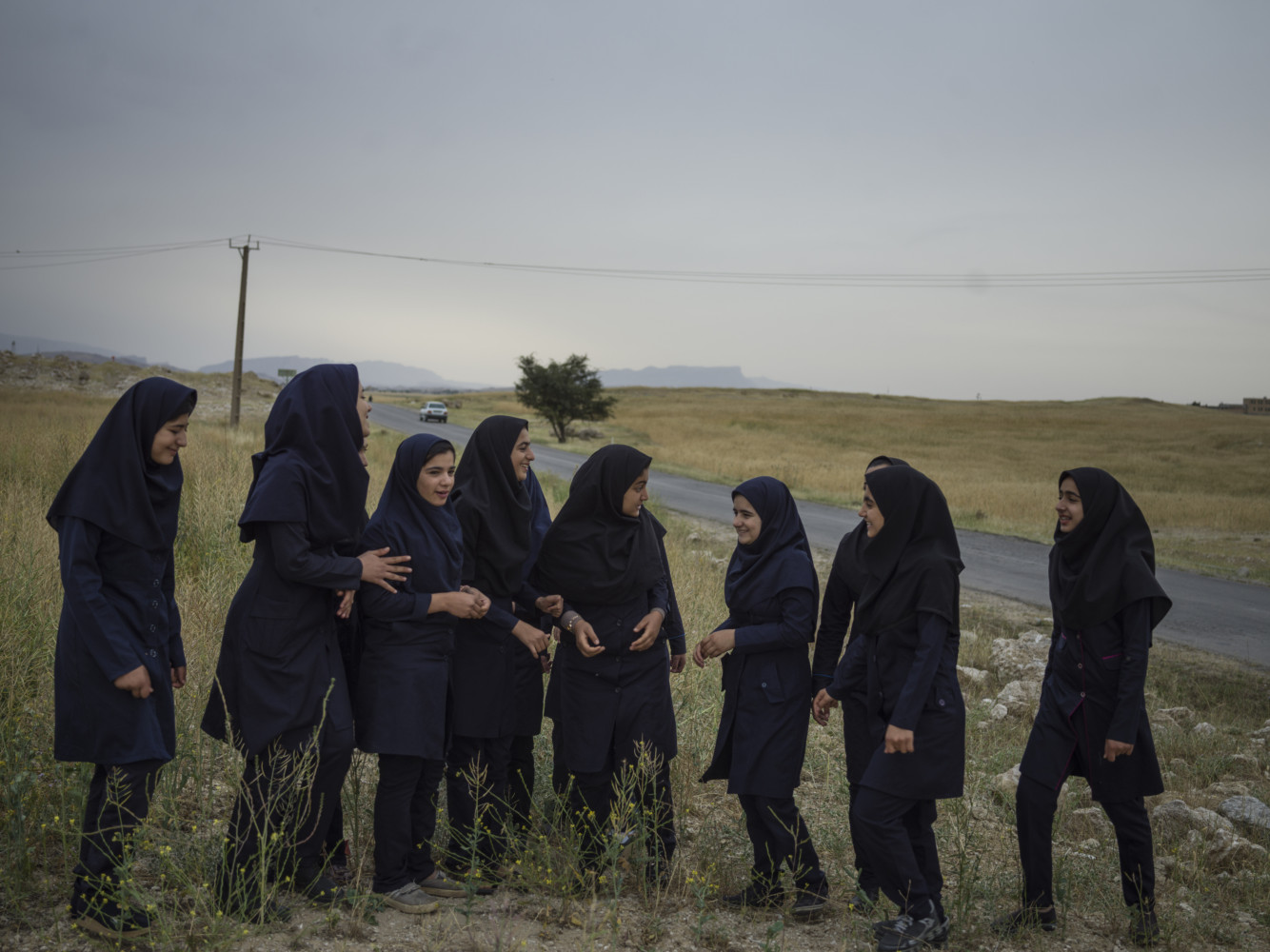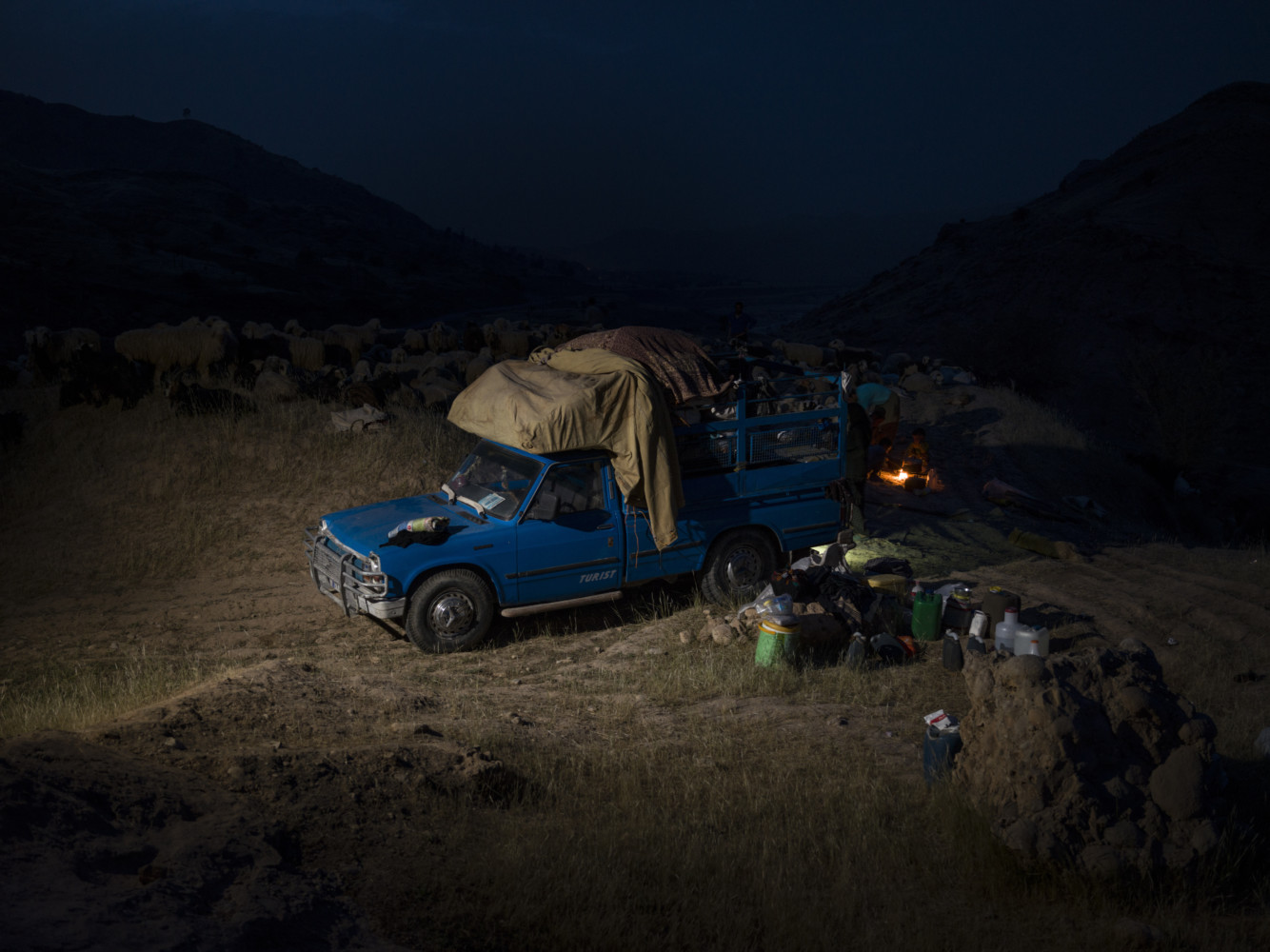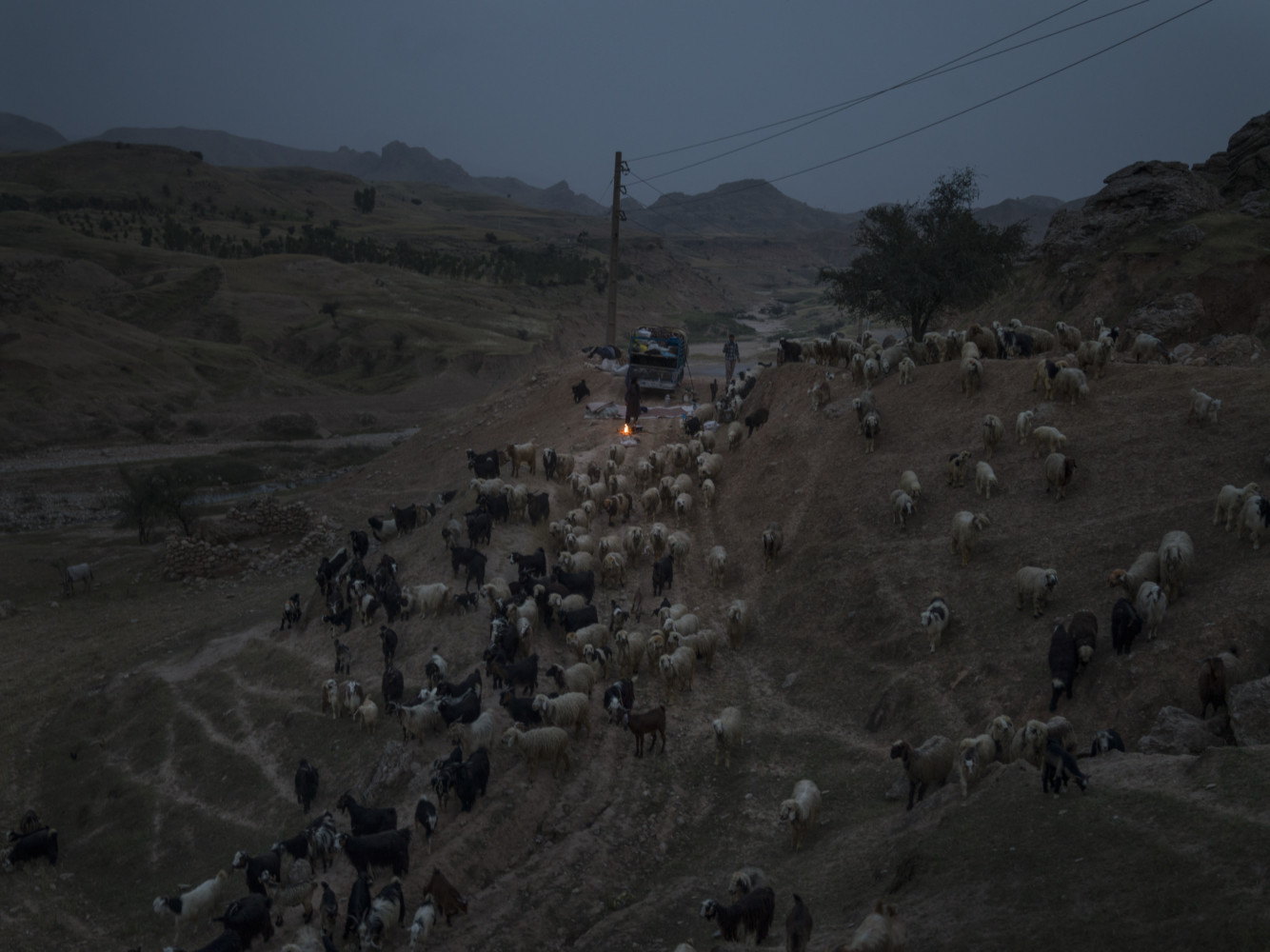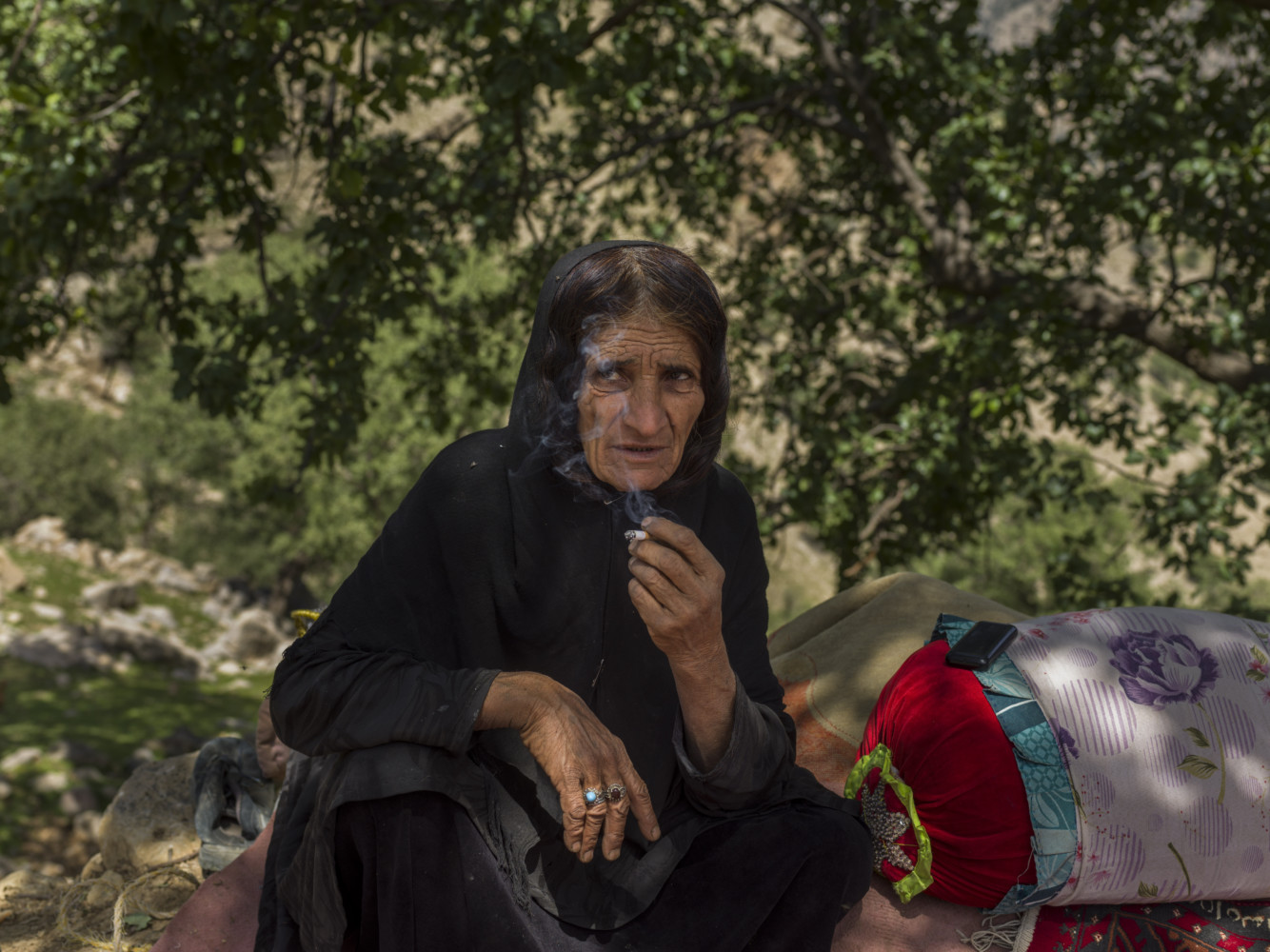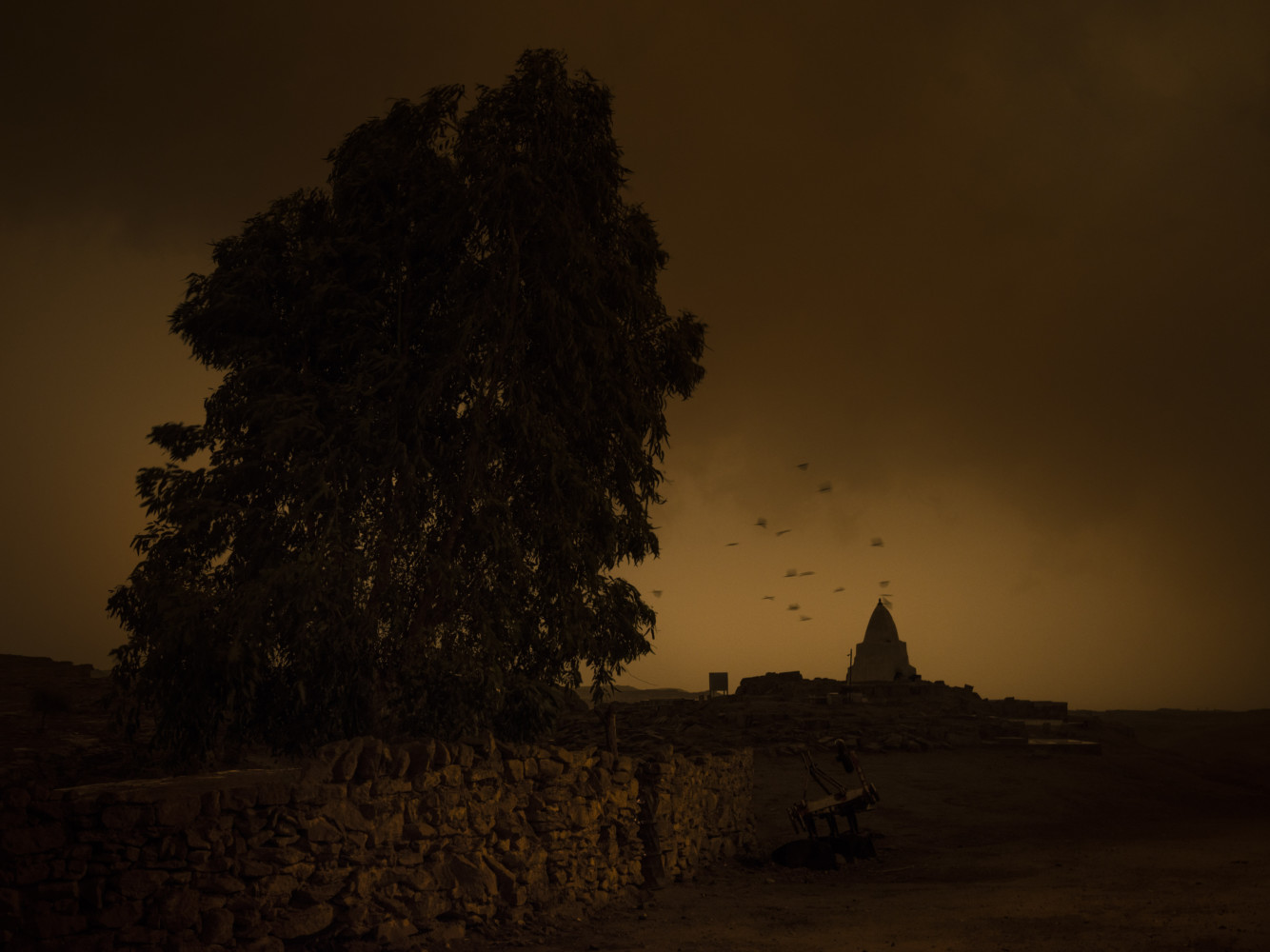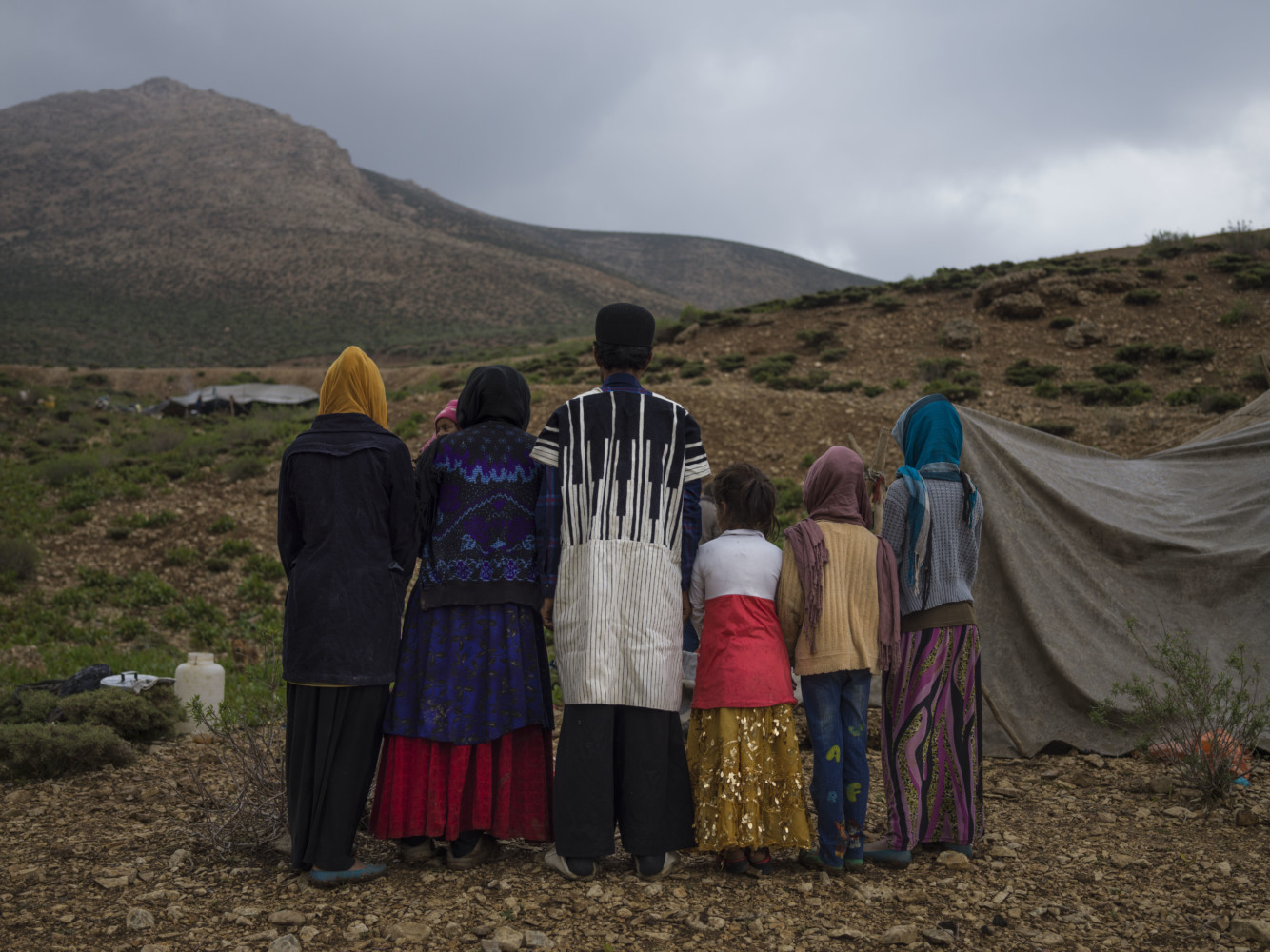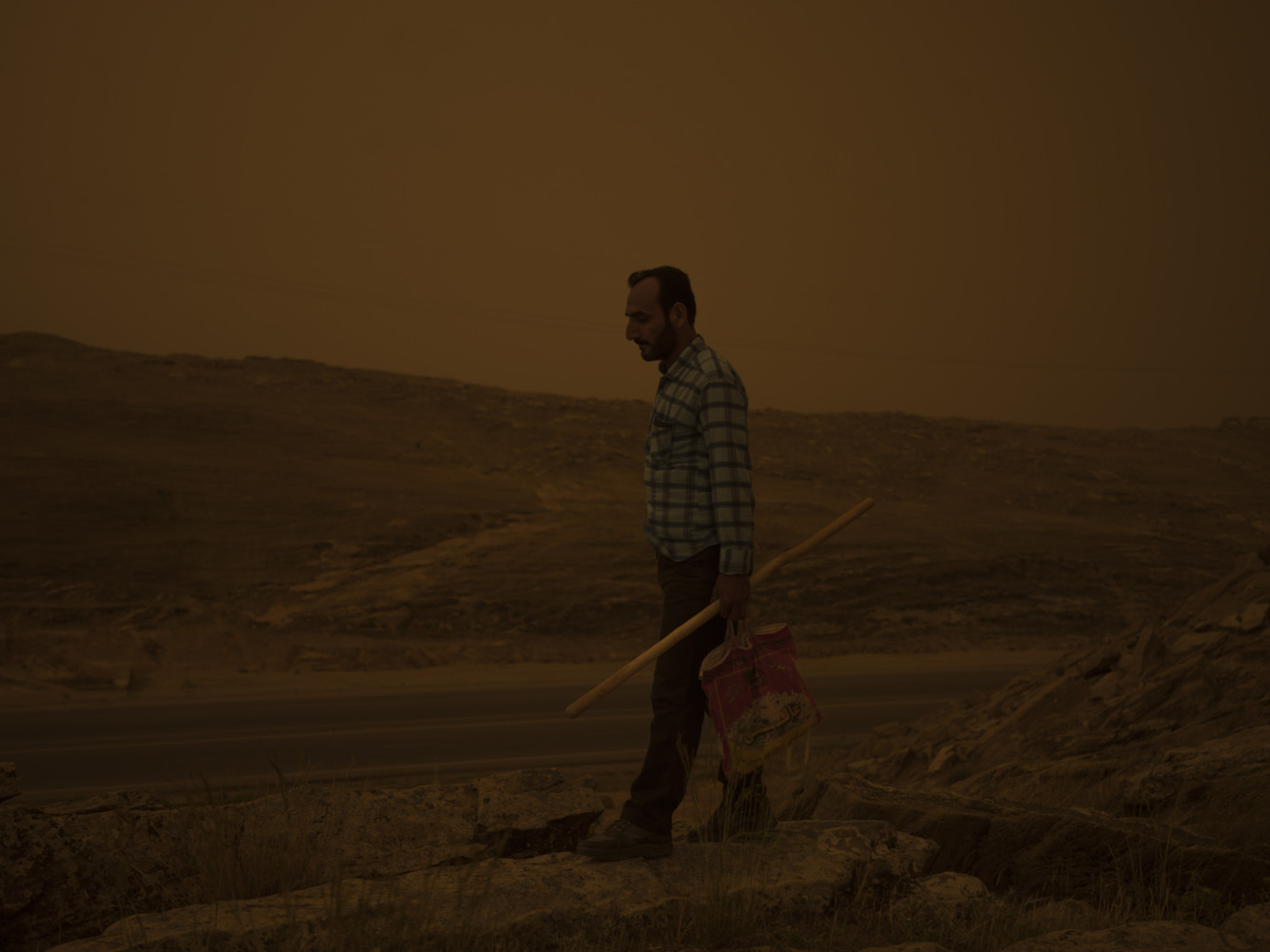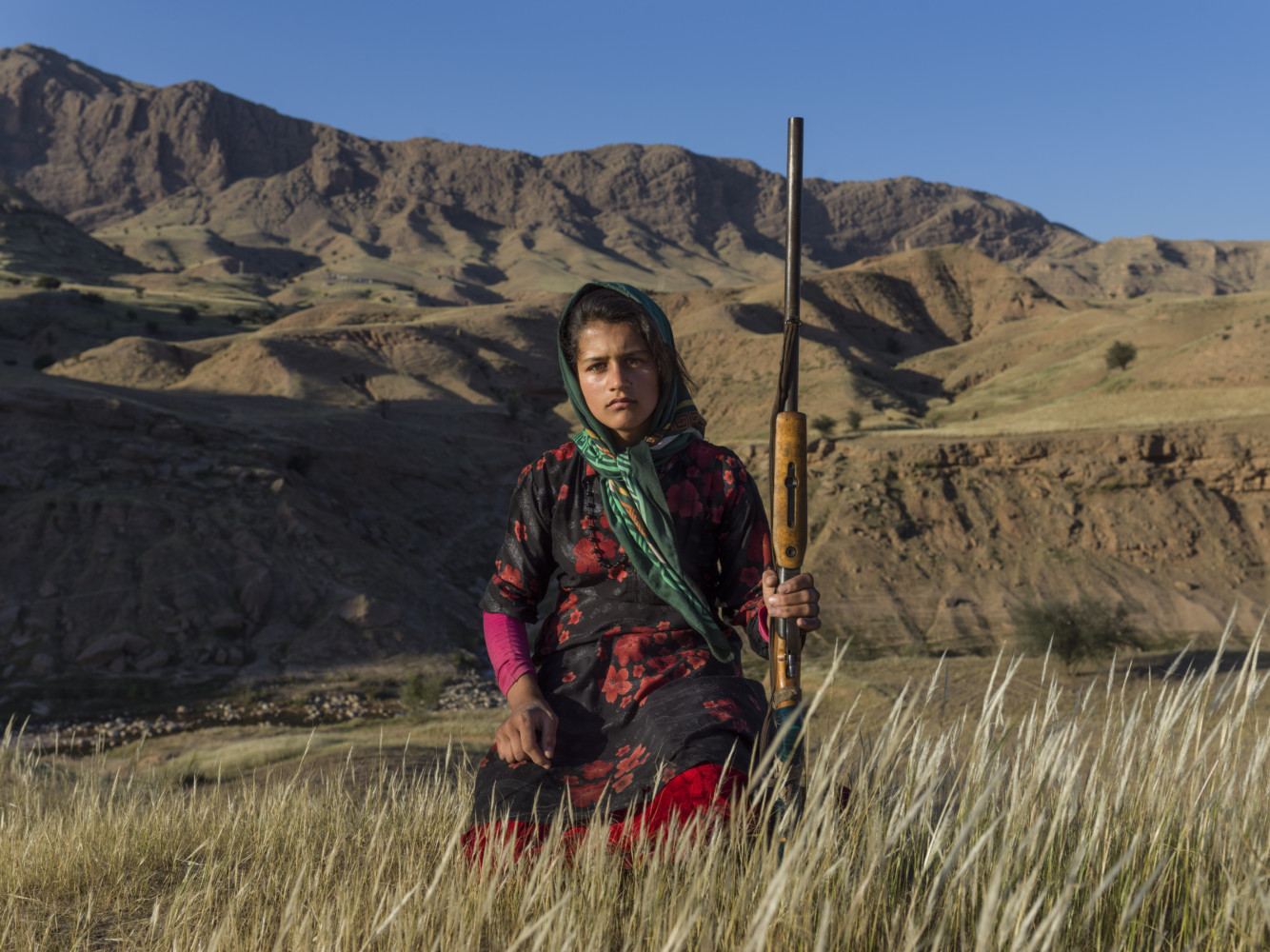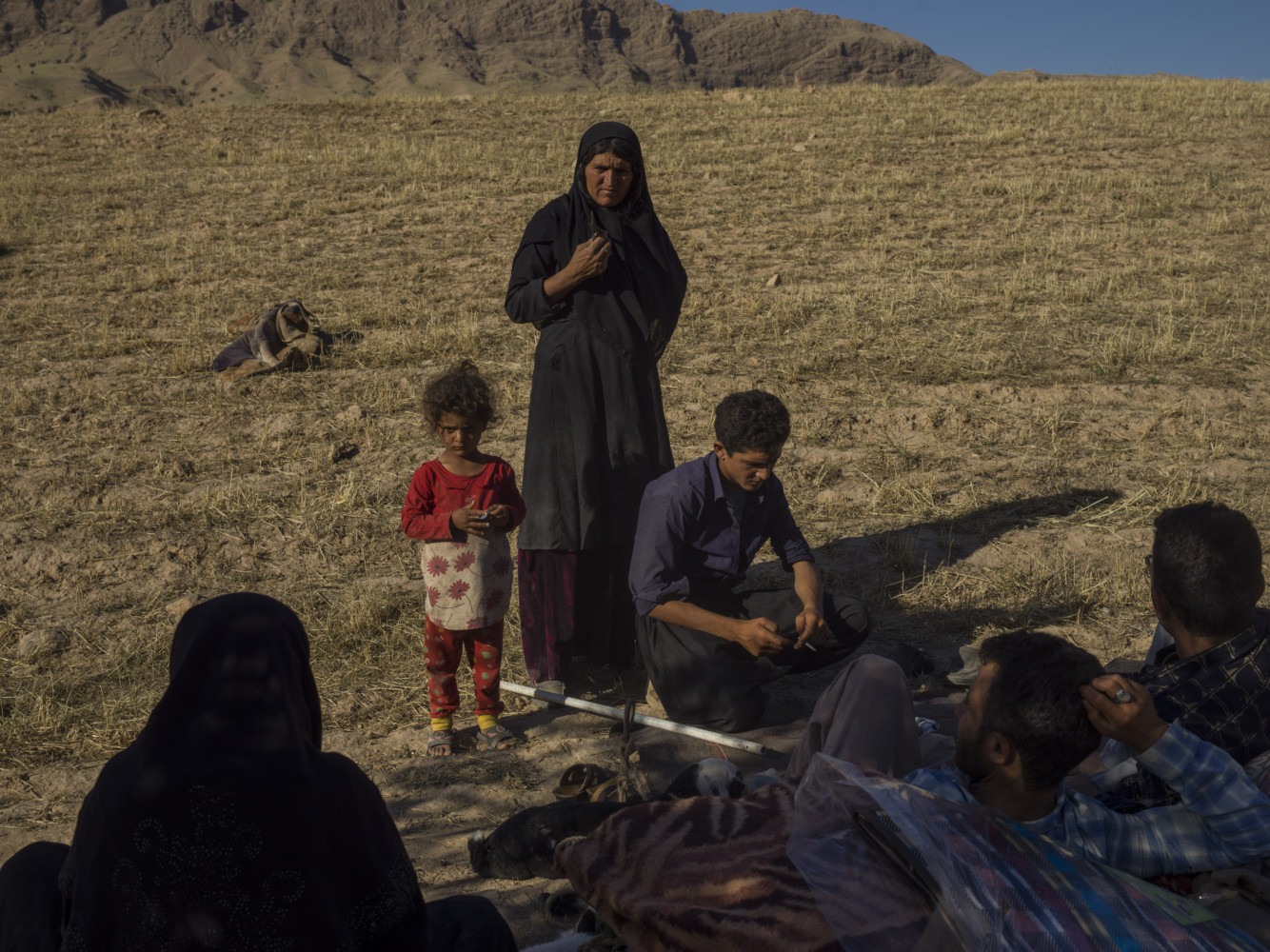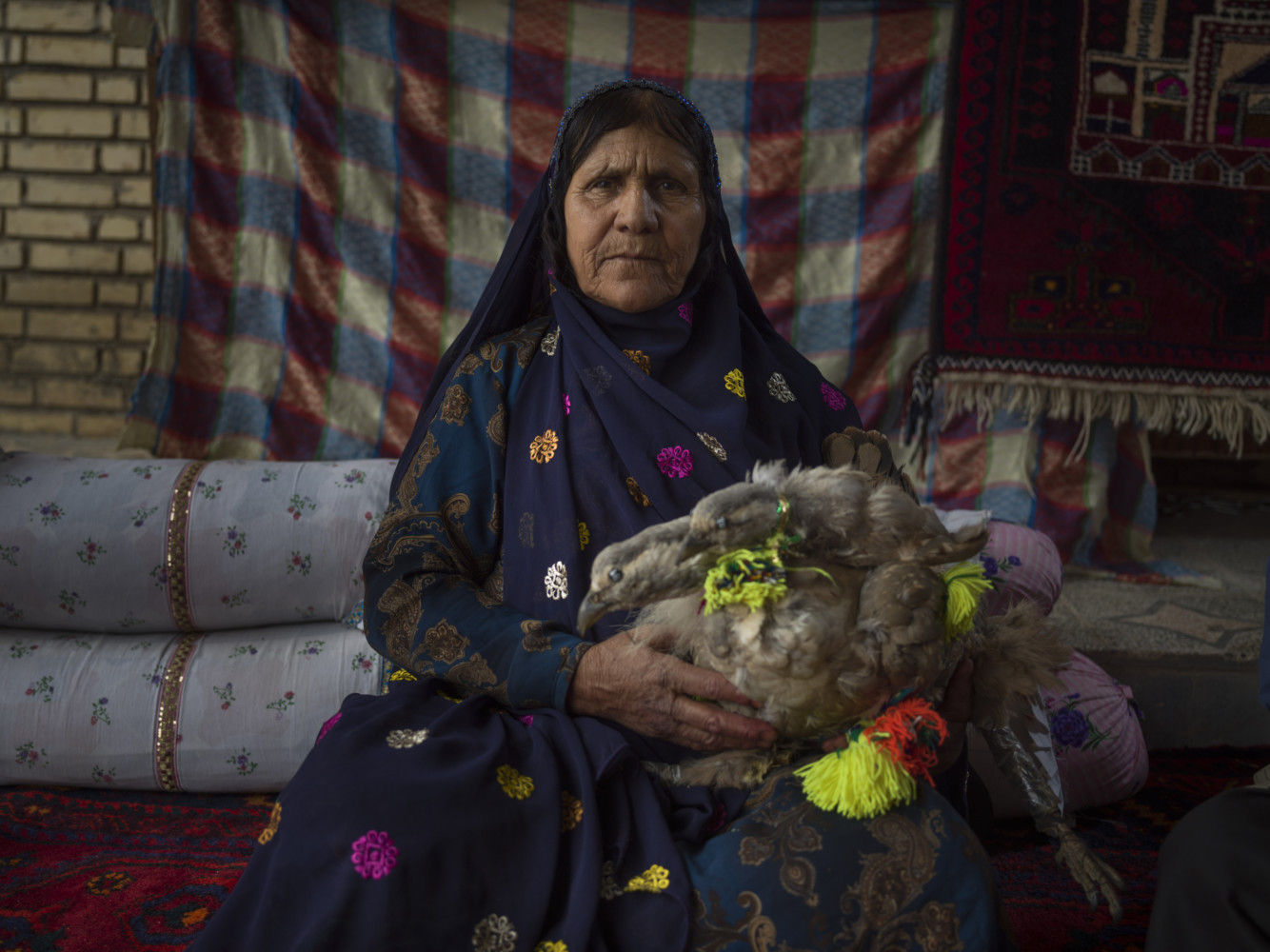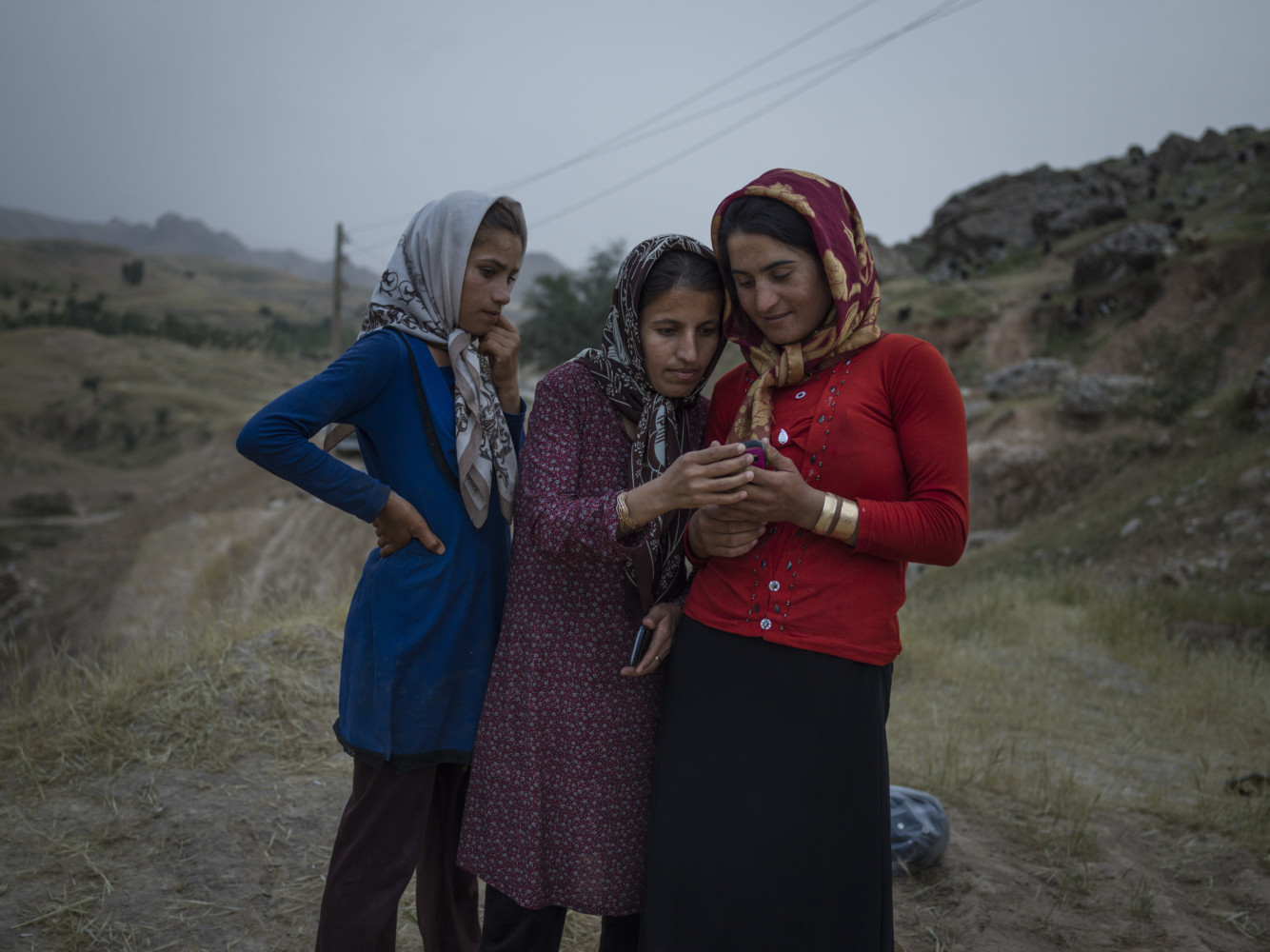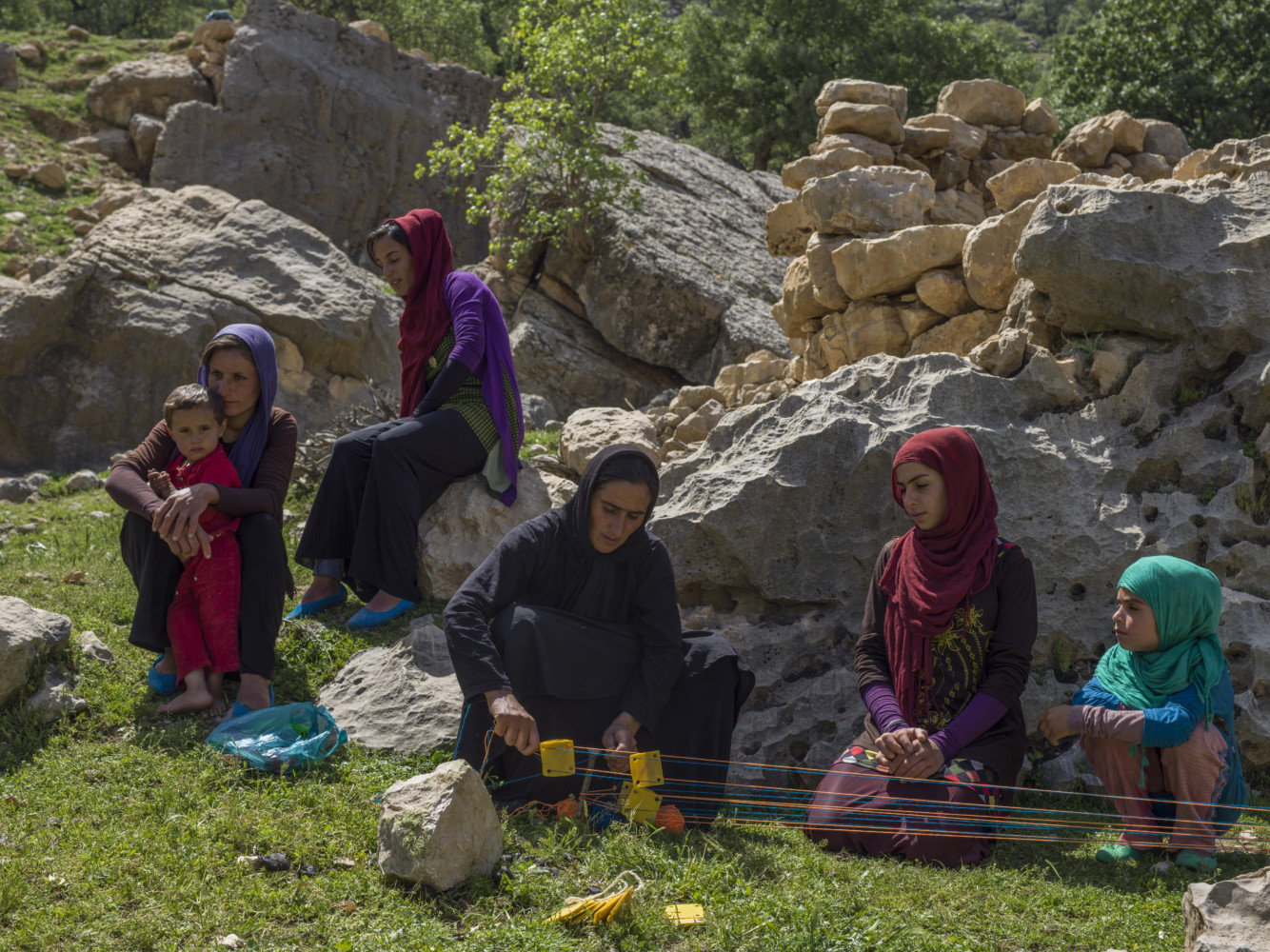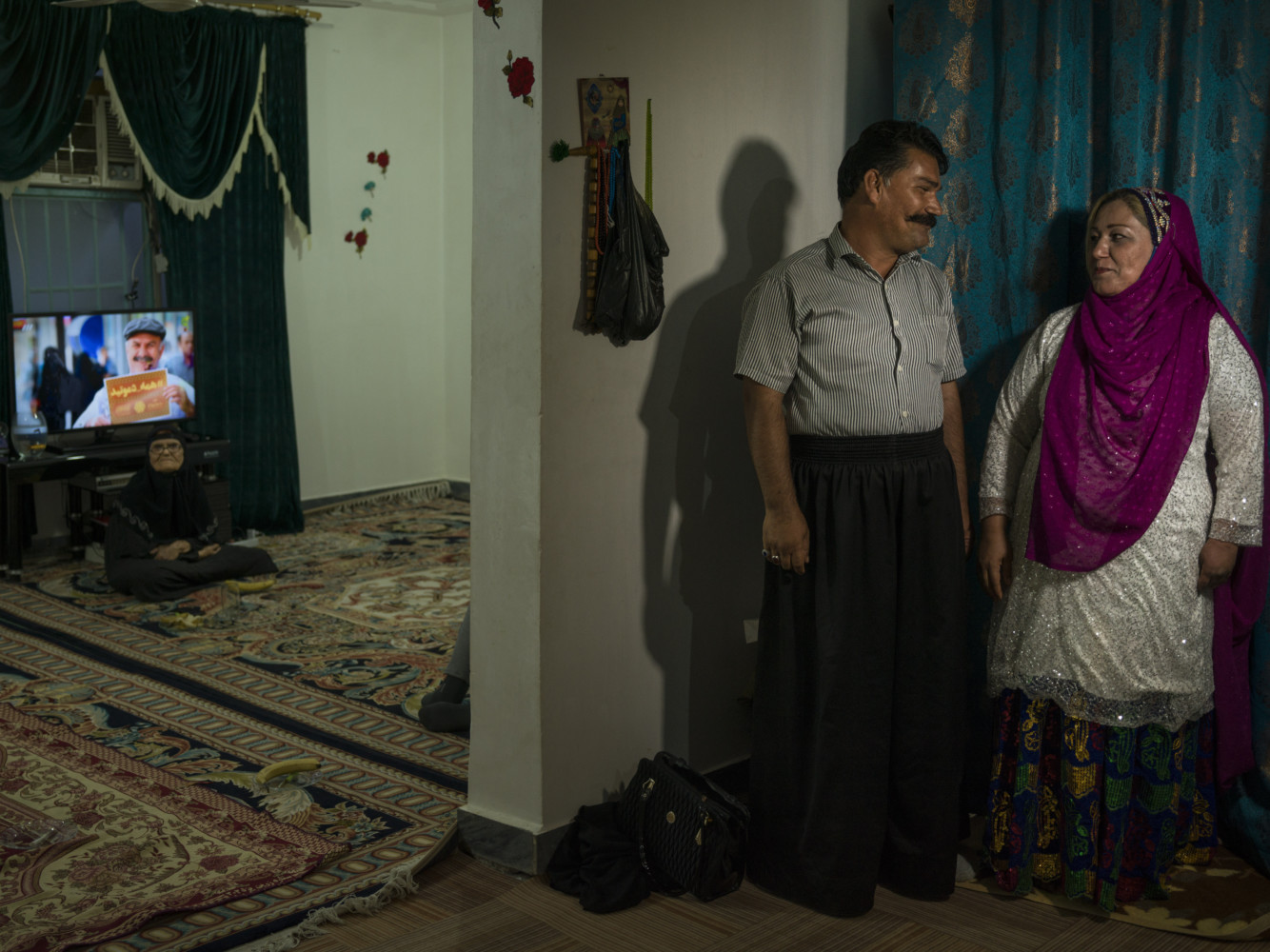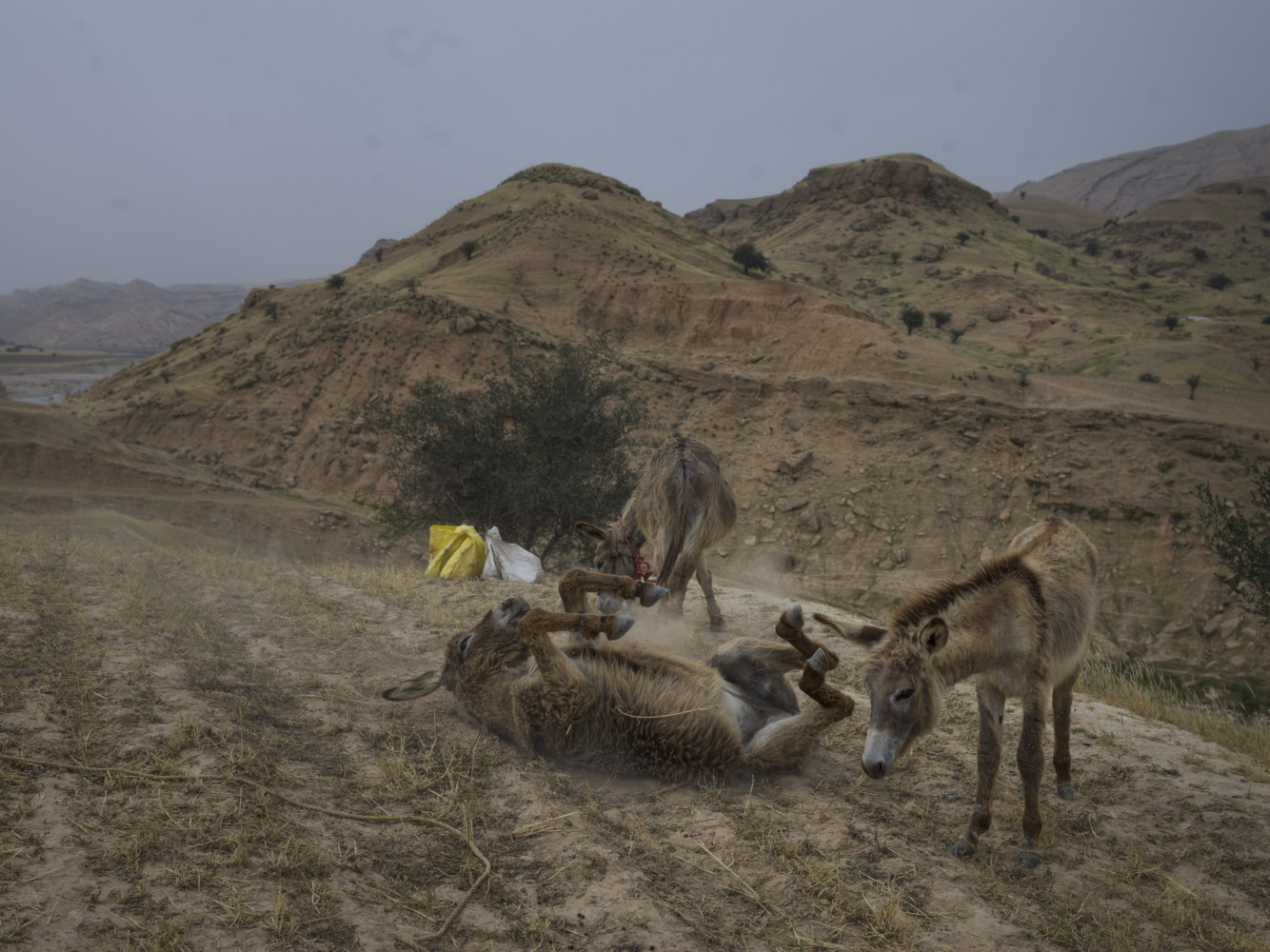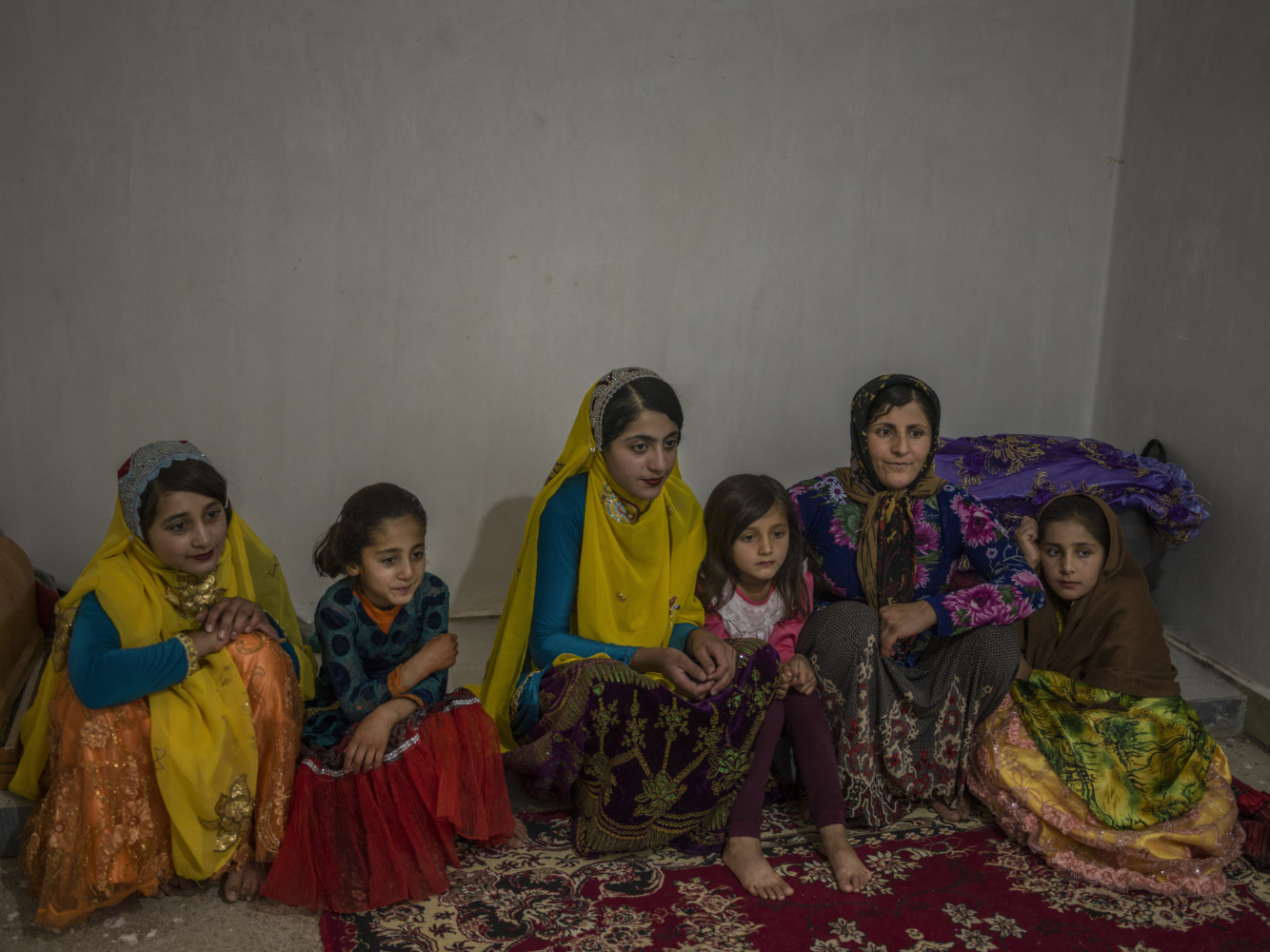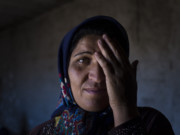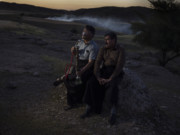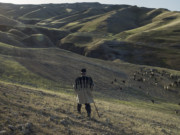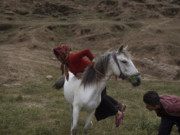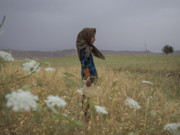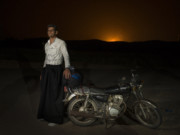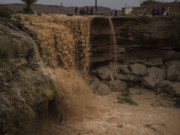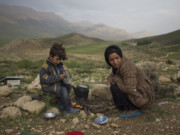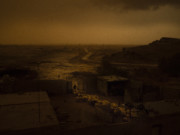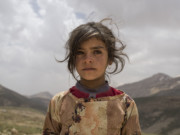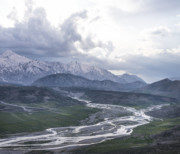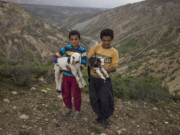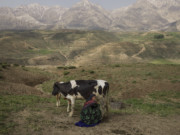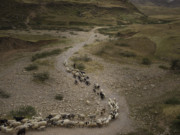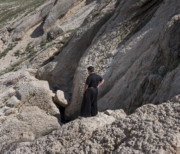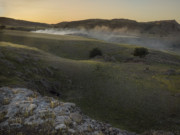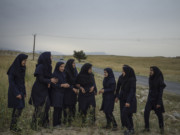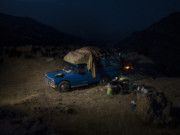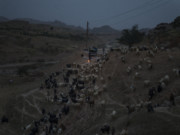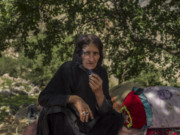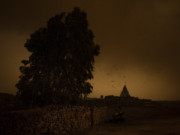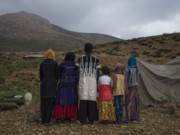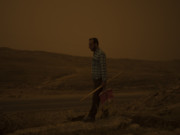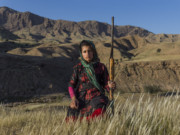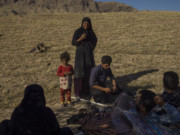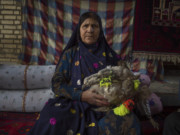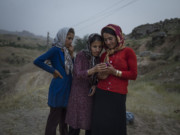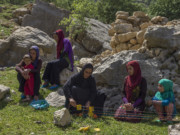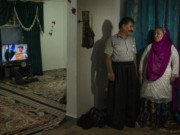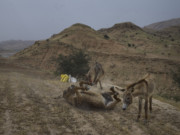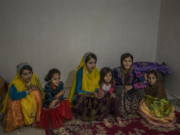Newsha Tavakolian IRAN. Khuzestan. 2018. Mahnaz Gheybpour, 41 years old, has 6 children. Her husband is Farshid Amani, 44 years old. They move between Khuzestan and Chaharmahal and Bakhtiary Province but it has been (...)
10 years that they live in a house, one is in Darreh-Geli and the other that they are moving to is in Kouhrang and they are not living in a tent anymore. They just pack the pillows and clothes and take the flock and leave the other stuff in their house. Their neighbors will check on their house in the time they are away. “My 17 years old daughter says that I don’t want to get married. She wants to go to the university. Her father is fine with her decision and he would let her study and stay single. For me it was totally different, My father used to hit me and stopped me from going to school. He believed that girls shouldn’t study and that’s a shame. I won’t let my daughters to marry a nomad. The nomadic life is horrible and I want them to live in a city. As an example, my mother is really sick and she is suffering from diabetes. I won’t see her for 6 months and I don’t even have a phone to call her and check on her. My daughter telling me all the time that why should I get married and make my life so miserable like yours. Divorce is becoming a common thing mostly because of the men’s bad behaviors and addictions. I went to my father’s house last year and stayed there for a few months until my husband quitted smoking Opium. Now he is much better and I can stand his attitude.
I got married when I was 16. I believe that I was a child back then. Few weeks ago, I was in a wedding ceremony and the bride was almost 12 years old. I asked the others what would they do to her afterward? They all answered the same thing that happened to you in your wedding night.
Non of my children got married. 2 of them are university students and Ali, 21 years old is the only one who wants to get married and he hurts himself to make us accept that. © Newsha Tavakolian | Magnum Photos
Newsha Tavakolian Left: Mehdi Ghafari, 41 Years old, Bakhtiari Folklore Singer with his colleague and friend Eydi Shams, 50 years old folklore musician smoking Shish-a in a small cafe close to their home town. They (...)
spend the weekends in this cafe running by a local man to pass time and it’s a reminder for them of those times they used to move as nomads. Now they are living in a house in Lali town. Khuzestan. Iran. 2018. Made with support from the Pulitzer Center. © Newsha Tavakolian | Magnum Photos
Newsha Tavakolian IRAN. Khuzestan. 2018. an Mohammad Najaf, 77 years old, has been a shepherd for 40-50 years. He has 2 daughters and 2 sons. Non of them wanted to travel with their parents and they preferred to liv (...)
e in a small city named Lali, Close to Ahvaz. They own a flock of 300 sheeps and goats. Mohhamad Najaf: “These mountains used to be like heaven, it was green as far as you could see but Now everything has changed and we have to go far away in search of grasslands. As there are no Water and grass on the way anymore we have to move with the cars since 15 years ago. It is getting worse each year.” © Newsha Tavakolian | Magnum Photos
Newsha Tavakolian Soraya Mokhtari, 7 years old, standing in a land in front of her grandparents house. Soraya and her cousins are now living with their grandparents in a house who came up to this solution which let (...)
the grandchildren to study and their parents to move with Bakhtiaris and take care of the flocks. Her class formed in the open area as the weather was so nice. Khadjeh Abad Village, Khuzestan. Iran. 2018. Made with support from the Pulitzer Center. © Newsha Tavakolian | Magnum Photos
Newsha Tavakolian IRAN. Khuzestan. 2018. Ebrahim Rostami, 45 years old born in Najaf Abad, Isfahan Province has a 1year old daughter and living a nomadic life. “Nomadic life is great but I can’t see anything positi (...)
ve in it anymore, It’s getting harder. I’m gonna sell my flock next year and look for a job in the city because of my daughter’s future.” © Newsha Tavakolian | Magnum Photos
Newsha Tavakolian IRAN. Piere-Cary Village, Khuzestan. 2018. Massive waterfall after the dusty storm and rain in Pier-Cary village, on the way to Shoushtar town, Khuzestan province. Water is combined with dust and m (...)
ade a muddy combination which is still a sign of blessing for the local people who are struggle and deal with drought. © Newsha Tavakolian | Magnum Photos
Newsha Tavakolian Shirin Khodadadi, 26 years old sitting with her son by the fire making tea. Khodadadi family spent the night by the road where the driver, they’ve paid to bring them to Chaharmahal and Bakhtiari pr (...)
ovince, forced them to get out of the car while he said he couldn’t drive further. They called another driver to pick them up. Zardkuh, Chaharmahal and Bakhtiari. Iran. 2018. Made with support from the Pulitzer Center. © Newsha Tavakolian | Magnum Photos
Newsha Tavakolian Pier-Cary village on the way to Shoushtar City. The residents used to have a nomadic life but after time they decided to live in a house and stay. The rain was the first one there after almost 20 y (...)
ears said by local people. Made with support from the Pulitzer Center.
Dust storm in Khuzestan Province. During the storm the morning sky looks darker than night and start to rain which called “The medicine after the death” by the local people. Khuzestan is facing serious drought. Many believe the dust caused by drought and the lands becoming dessert around Iran-Iraq border.
A shepherd moving his flocks inside of a shelter during the dusty storm and rain which caused the whole village to be muddy. It is raining after 20 years but the local people call it: “The medicine after death.” On the way from Masjed Solayman to Shoushtar in Peier-Kary Village. Piere-Cary Village, Khuzestan. Iran. 2018. © Newsha Tavakolian | Magnum Photos
Newsha Tavakolian Marzieh Seyfouri, 8 years old and her family just arrived from Khuzestan province to Zardkouh lands to find grass and water to feed their flock. She doesn’t like their tent and she loves to go to s (...)
chool which she goes in Khuzestan. Zardkuh, Chaharmahal and Bakhtiari. Iran. 2018. Made with support from the Pulitzer Center. © Newsha Tavakolian | Magnum Photos
Newsha Tavakolian IRAN. Zardkuh, Chaharmahal and Bakhtiari. 2018. A view of Zardkouh mountain, the highest peak in the Zagros mountains. Taraz road which is the main road of Bakhtiaris seasonal journey between Khuze (...)
stan and Chaharmahal-and- Bakhtiari provinces passes through Zardkouh mountain. Bakhtiaris used to pass Zardkouh on foot and now they move with the help of cars and trucks. Many families with economical problem which doesn’t allow them to rent a truck still pass the mountain on foot. There many accidents happening each year for Bakhtiaris during moving towards Taraz road such as Avalanche or thieves. © Newsha Tavakolian | Magnum Photos
Newsha Tavakolian Portrait of Esmaiel Karimi, 12 years old left and his brother Gholamreza, 14 years old holding their baby goats in Zardkouh mountain, Chaharmahal and Bakhtiari province where they live in summers. (...)
Zardkuh, Chaharmahal and Bakhtiari. Iran. 2018. Made with support from the Pulitzer Center. © Newsha Tavakolian | Magnum Photos
Newsha Tavakolian Pari Karimi, 48 years old milking the cows. She loves to live in a town but after her husband’s decision they are still living in a tent with their son and his bride. In nomads families men decide (...)
for all the family matters. Zardkuh, Chaharmahal and Bakhtiari. Iran. 2018. Made with support from the Pulitzer Center. © Newsha Tavakolian | Magnum Photos
Newsha Tavakolian A man (Ali Hemmat Badri) standing at the top of Kouhrang fountain, which helps supply cities like Isfahan, Shahrekurd and Yazd with water. Since the era of Shah Abbas l, attempts have been made to (...)
divert the Kouhrang to Zayandehrood and Karun river. The fountain rises in the Yard Kouh Mountains of the Bakhtiari district in the Zagros range. Zardkuh, Chaharmahal and Bakhtiari. Iran. 2018. Made with support from the Pulitzer Center. © Newsha Tavakolian | Magnum Photos
Newsha Tavakolian IRAN. Khuzestan. 2018. The view of Chamsoor Lands, Khuzestan Province, used to be one of the main roads for Bakhtiari nomads to move but now due to drought and lack of grasslands the nomadic famili (...)
es just cross it with their rented cars and trucks. © Newsha Tavakolian | Magnum Photos
Newsha Tavakolian Girls on their way to Bibi Maryam Boarding school in Sardasht city. They spend almost 2 hours on the way from their house in villages to the school. Most of their families are nomads who decided to (...)
stay in a village house to help their kids study. The Student spend the whole week in school and the weekend in their house. The families who have chosen this life style will move after their kids final exams. “ We all are great students in this bus and we all want to be a doctor. During the week in school we have to Give our mobiles to our teacher and she will let us have them only 30 minutes a day to call our family. Some of us are engaged but our finances let us to study and have no problems with it.”
The school Bibi Maryam has been named after Sardar Maryam Bakhtiari who was a Nomad Lurish revolutionary and activist of the Iranian Constitutional revoltion. As a military commander, she played a distinguished role when Bakhtiari tribal forces with help of modern arms from German Empire successfully captured Tehran in 1909 as part of the revolutionary campaign to force the central government to establish democratic reforms. The Bibi Maryam boarding school with the capacity of 100 girls students, used to be a boys only school. Now it’s a girls only school since the are more girls in nomads family who would like to continue their education. The headmaster, Mrs. Kiani, believes that even with the difficulties they are facing mostly by the families, they are getting better each year. “The situation had changed during the last 16 years. Families trust us more and more each year and let their daughters to stay here for the night, which is not very common since most of the Bakhtiari families believe that the girls should spend the nights under the same roof with her father of brothers. We struggled a lot, we keep going door to door to get the girls permission from their father to continue their education. Khuzestan. Iran. 2018. Made with support from the Pulitzer Center. © Newsha Tavakolian | Magnum Photos
Newsha Tavakolian Zamani Family spending the night on the way to Chaharmahal and Bakhtiari province. Bakhtiari families stop by a river and close to grasslands to spend the night on the moving. They are using techno (...)
logies such as mobile phones and solar lamps. Khuzestan. Iran. 2018. Made with support from the Pulitzer Center. © Newsha Tavakolian | Magnum Photos
Newsha Tavakolian A flock gathering on a heel close to theirs owner and shepherd to rest for the night. Dogs will take care of them during the night. Thief and wolf are the main dangers for them on the moving way. B (...)
eside finding water and grasslands on the way, those dangers make many families to pay a price to move the flock with trucks and get to the country sooner. Khuzestan. Iran. 2018. Made with support from the Pulitzer Center. © Newsha Tavakolian | Magnum Photos
Newsha Tavakolian Shahpari Mohammadi, 53 years old, smoking a cigarette. I am suffering from many sorrows in my life, that’s why I’m thinner than many other Bakhtiari women. My life is a tragedy. I lost my brother i (...)
n a car accident, he was only 25 years old and had a 1 year old daughter. He was so handsome as if he came from a fairytale. If I had an image of him and I could show you. You would put your hand on your eyes because of his beauty and innocent face. I started smoking Shish-a at the time I gave birth to my first son and it has been a few years that I smoke cigarette instead. Smoking cigarettes is not a common thing for women in nomadic life. It’s possible to say that women would become a grown up person for the others at the time they give birth to a boy. “ It’s not in our nature to ask for our inheritance.” Women asking for their rights and inheritance is a huge deal within Bakhtiari since they believe that men should always have the power in family. Sousan Sorkhab, Khuzestan. Iran. 2018. Made with support from the Pulitzer Center. © Newsha Tavakolian | Magnum Photos
Newsha Tavakolian Pier-Cary village on the way to Shoushtar City. The residents used to have a nomadic life but after time they decided to live in a house and stay. The rain was the first one there after almost 20 y (...)
ears said by local people. Dust storm in Khuzestan Province. During the storm the morning sky looks darker than night and start to rain which called “The medicine after the death” by the local people. Khuzestan is facing serious drought. Many believe the dust caused by drought and the lands becoming dessert around Iran-Iraq border. Piere-Cary Village, Khuzestan. Iran. 2018. Made with support from the Pulitzer Center. © Newsha Tavakolian | Magnum Photos
Newsha Tavakolian Ali Hasan Darvishi, 40 years old standing with his wife Ghashang DArvishi, 37 years old and their children in front of their tent. They are cousins who fell in love with each other. Zardkuh, Chahar (...)
mahal and Bakhtiari. Iran. 2018. Made with support from the Pulitzer Center. © Newsha Tavakolian | Magnum Photos
Newsha Tavakolian IRAN. Piere-Cary Village, Khuzestan. 2018. Tahmasb Rahmani, 34 years old is a single shepherd who is feeding his flock illegally as he couldn’t find any grassland around. He is thinking to sell his (...)
flock and live with its money. He is a shepherd since he was a little boy. “Shepherding has been always difficult but this year is like a nightmare, there is no solution for me other than selling my flock. I haven’t think of what I am going to do next. At the moment I just know that I don’t want to continue like this.” © Newsha Tavakolian | Magnum Photos
Newsha Tavakolian Masoumeh Ahmadi, 14 years old, who wants to be called by the name Golbahar since Masoumeh is a very old fashion name and not very popular Among the young generation, standing in Chamsoor lands in K (...)
huzestan Province while holding guns. It is really common among Bakhtiaris for each person to have their own guns. Each family might have 3 or 4 guns that are mostly for mens. Women can have their own gun after they get married with the approval of their husband and father. Many of them receive their gun as a gift from their husbands right after they give birth to their first son. Masoumeh borrowed her mother’s gun occasionally. Masoumeh couldn’t study as she had to help her mother and the family doesn’t allow her to go to school. Her mother says that we are waiting for a “customer” for our daughter, which in their language means a man who ask them to marry them and might give the family a horse or a gun in exchange. Khuzestan. Iran. 2018. Made with support from the Pulitzer Center. © Newsha Tavakolian | Magnum Photos
Newsha Tavakolian IRAN. Khuzestan. 2018. Chamsoor Lands close Lali’s fault in Khuzestan province in southwest of Iran with the oldest history, it is often reffered to as the “birth place of the nation”. Khuzestan ha (...)
s still maintains its diverse group but it does have Arabs, Persians, Bakhtiari and ethnic Qashqais and Lors. Khuzestan province is now facing dust storms, dried-up rivers and mounting pollution. While Khuzestan is best known as Iran’s oil-rich province, it also lies in the fertile crescent, on some of the earth’s best water and land. More than 1m hectares of its land are agricultural, and it provides the country with crucial crops during the cold seasons. But this is changing as the rivers die out.
Amiri and Ahmadi’s families are neighbors and are moving together. They have their kids married to each other and they are also relatives now.
Bibi mah, 45 years old, standing with her daughter Saba, 3 years old. The mother does all the works with her daughters and the father Yadollah,61 years old joins them only at nights to do his drugs which is mostly opium. © Newsha Tavakolian | Magnum Photos
Newsha Tavakolian Nistar Mokhtari, 66 years old in a Bakhtiari tent they set up in their village house in Khajeh Abad, Khuzestan Province. The couple decided to stay in a house to help their grandchildren to go to s (...)
chool and study. They get used to living in a tent so that they made one in the yard to spend the days in it. Their daughters and sons keep moving with Bakhtiari and they are taking care of their grandchildren together. She is holding a Sandgrouse bird Shot by their son few weeks ago and they are using it for decoration. Bakhtiari nomads believe hunting this special bird Causes bad luck. Khadjeh Abad Village, Khuzestan. Iran. 2018. Made with support from the Pulitzer Center. © Newsha Tavakolian | Magnum Photos
Newsha Tavakolian Parisa Mohammadi, 10 years old,Pooran Mohammadi, 15 years old, Parijan Mohammadi, 18 years old and Zahra Mohammadi, 20 years old watching their Uncle’s wife Fatemeh Mohammadi, 28 years old making a (...)
toy for the kids with colorful strings and Spiny pieces. Pooran’s parents got divorce few years ago and now she is living with her grandma and her dad along with her 4 siblings. Number of divorces are raising among nomads as the situation changed, before it was really bad for a woman to get divorce. Pooran’s mother , according to Fatemeh, her sister in law, has many proposers but she will stay single in order to have the right to meet her daughters. Fatemeh: “getting married is like something that had been written for you even before your birth. It’s all about luck. For me there is no right to decide wether I want to live in the city or move, that’s all my husbands decision and I have to go after him. I call a girl who would live in a city after her marriage a lucky one even if her husband hits her or treats her badly. That’s bad luck! My husband is my second cousin. They came to propose me, I didn’t say a word. My uncle accepted him to be my husband. I always think of divorce. It’s been almost 7 years that I got married. It’s been 7 years that I’m not happy and satisfied with my life, that’s why I’m always wearing black, Black mirrors inside of my hearth.” Fatemeh has 2 kid. A daughter, Tina mohammadi, 2 years old and Farshid Mohammadi, 5 years old. Sousan Sorkhab, Khuzestan. Iran. 2018. Made with support from the Pulitzer Center. © Newsha Tavakolian | Magnum Photos
Newsha Tavakolian Fatemeh Ghafari, 40 years old standing in front of a curtain which divide a room in her house with her husband, Mehdi Ghafari,41 years old, a folklore singer who mostly plays at Bakhtiari wedding a (...)
long with their son, Farhad, 19 years old.Her mother in law, called DA by the whole family,80 years old was a nomad but now she is living with them in a house in Lali town, Khuzestan Province. Ghafari family rent a house in Shahrekord, a city in Chaharmahal and Bakhtiar Province during the summer holidays and stay there for 3 month. Mr. Ghafari has is job there since there are many weddings there during the summer which is a place for whole Bakhtiari nomads to spend the summer. He believes that city life works for women the best since they have more free time and have less households. Lali, Khuzestan. Iran. 2018. Made with support from the Pulitzer Center. © Newsha Tavakolian | Magnum Photos
Newsha Tavakolian Donkeys having a rest after a long ride from Khuzestan to Chaharmahal and Bakhtiari Province. Bakhtiari Nomads pack and move most of their stuff on the donkeys and use them for transportation. Khuz (...)
estan. Iran. 2018. Made with support from the Pulitzer Center. © Newsha Tavakolian | Magnum Photos
Newsha Tavakolian Mokhtari Family in their house in Khajeh Abad village, Khuzestan Province. 11 kids are now living with their grandparents in a house who came up to this solution which let the grandchildren to stud (...)
y and their parents to move with Bakhtiari and take care of the flocks. They are wearing their Bakhtiari costume and dancing next to the open kitchen in their house. That’s the first time in their lives experiencing living a house. Khadjeh Abad Village, Khuzestan. Iran. 2018. Made with support from the Pulitzer Center. © Newsha Tavakolian | Magnum Photos
